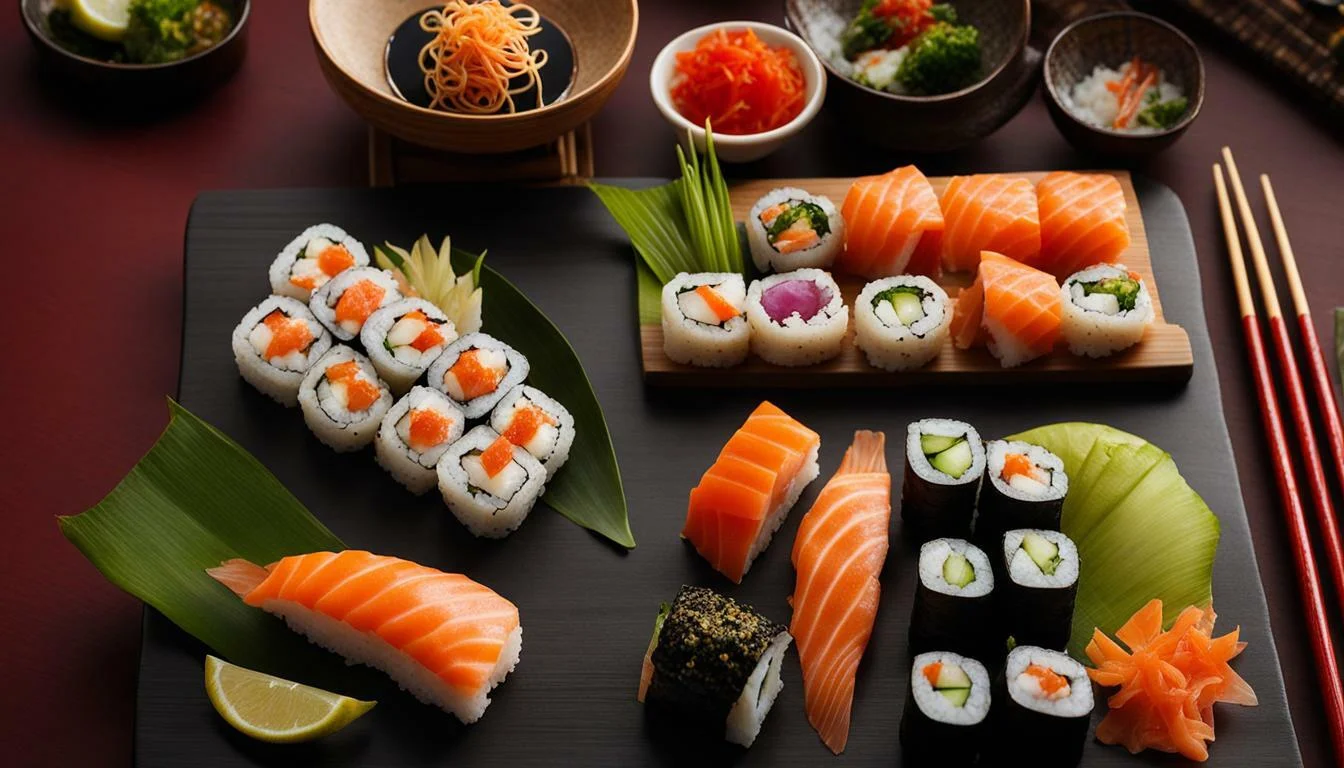Take Me to the Recipes
Embark on a culinary journey through the vibrant and diverse world of Japanese cuisine. Japan’s culinary landscape is a delightful fusion of tradition and innovation, offering a rich tapestry of flavors, textures, and cultural nuances.
In this article, we invite you to bring the authentic taste of Japan into your own kitchen, as we present a curated collection of 30 mouthwatering recipes that capture the essence of this extraordinary culinary tradition.
From iconic dishes like sashimi and ramen to lesser-known gems like chawanmushi and tonkatsu, this article is your gateway to mastering the art of Japanese cooking. Get ready to savor the umami, embrace the artful presentation, and immerse yourself in the culinary marvels that make Japanese food a global sensation.
Have you ever tasted sushi? If not, you’re missing out on one of Japan Cuisine’s most famous culinary exports. Sushi is not only a delicious dish, but also an integral part of Japanese culture and cuisine. Get ready to tantalize your taste buds and bring the essence of Japan to your dining table!
Take Me to the Recipes
Japan Cuisine – Key Takeaways:
- Sushi is the national dish of Japan, reflecting the country’s deep culinary heritage.
- Japanese food is renowned for its traditional dishes and unique flavors.
- Sushi is a beloved delicacy worldwide, made with fresh ingredients and meticulous techniques.
- Japanese food offers a diverse and delicious array of dishes, from sushi and sashimi to ramen and street food.
- Exploring Japanese food is an exciting culinary journey, full of cultural significance and delicious flavors.

Japan is located in the region called Northeast Asia or East Asia, to the east of the Eurasian continent. It is surrounded by the Pacific Ocean, the Sea of Okhotsk, the Sea of Japan, and the East China Sea.

Index of Contents
- Take Me to The Recipes
- More Articles for Your Pleasure
- Interesting Facts About Japan
- The Japan’s History and the Effect It Has Had on the Cuisine
- How Japan’s Climate and Geography has Influenced Japanese food
- Understanding the Essence of Japanese food
- What Is Japan’s National Dish?
- How Healthy is Japanese Food?
- Traditional Japanese Food
- Exploring the Japanese Ingredients: The Flavors of Japan
- Japan Cuisine – The Art of Sushi-Making
- National Dish of Japan – Sashimi – A Raw Delight
- Ramen – The Comforting Bowl of Goodness
- Tempura, Takoyaki, and More – Exploring Japanese Street Food
- 27 more recipes you can try at home
- Conclusion
- Frequently asked Questions
You may also be interested in the Following Articles
- North and South American Cuisine – A Culinary Expedition
- Europe Cuisine: Savor the Continent’s Best Culinary Secrets!
- African Cuisine: Discover the Bold Flavors & Global Charm!
- Asian Cuisine Unlock its Secrets – Taste, Health & Global Influence!
Savor iconic Japanese Food Recipes – Click on each tantalizing picture to open up the Recipe.
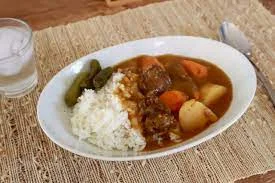
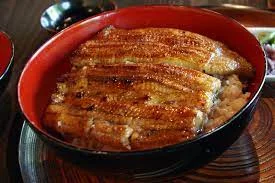
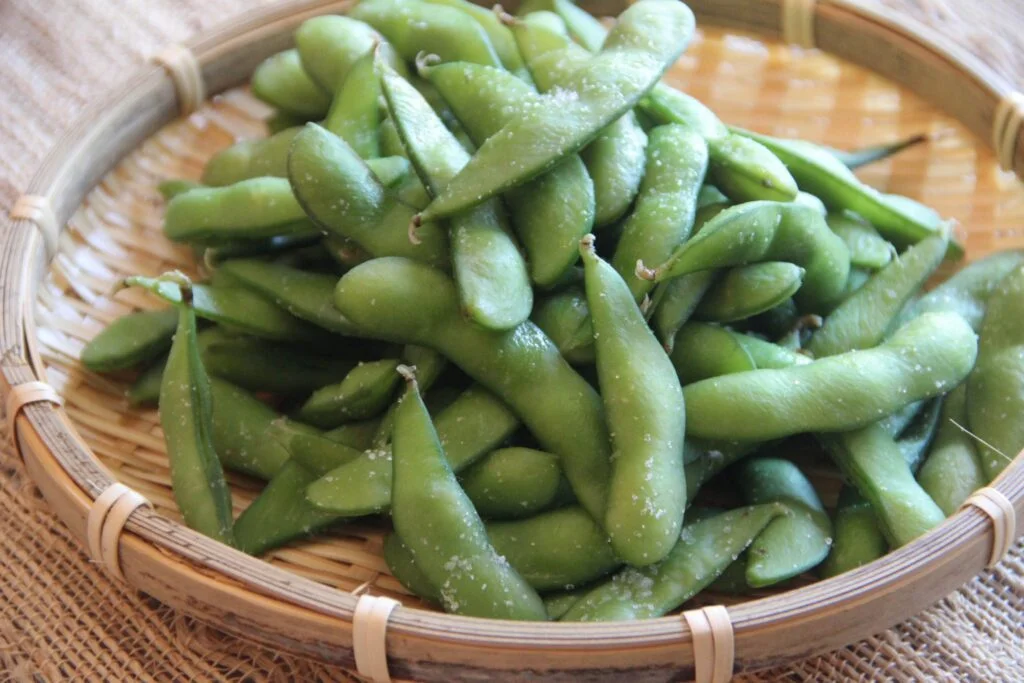
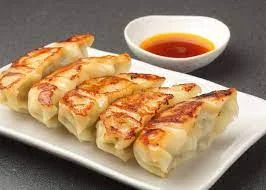
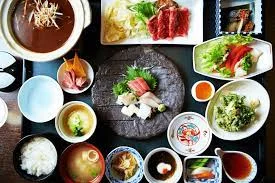

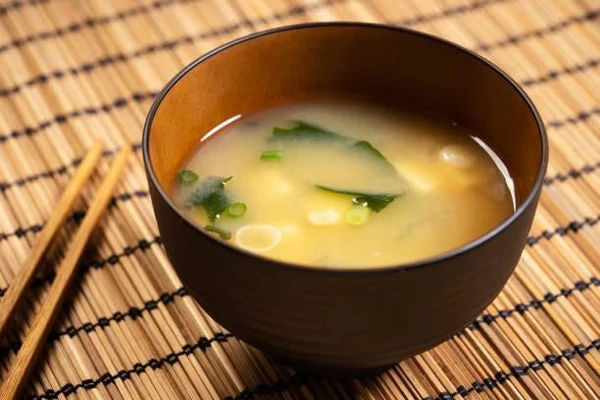
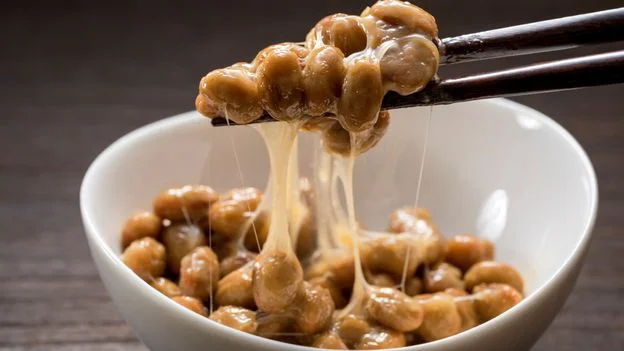
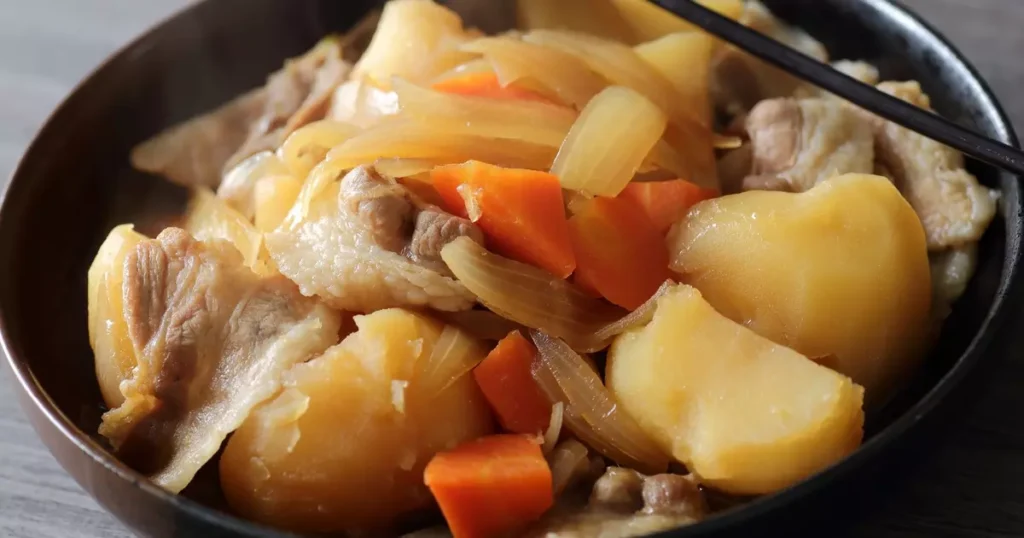
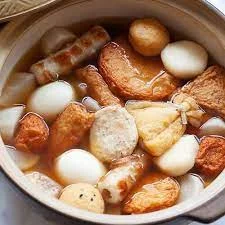

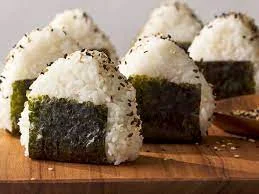

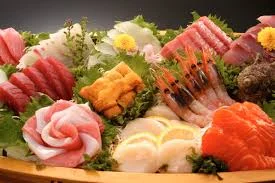
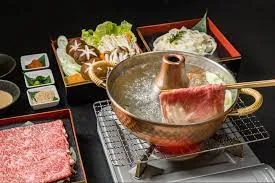

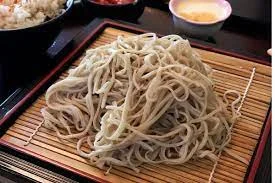
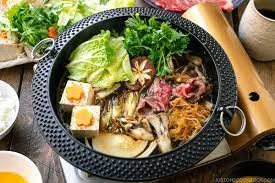
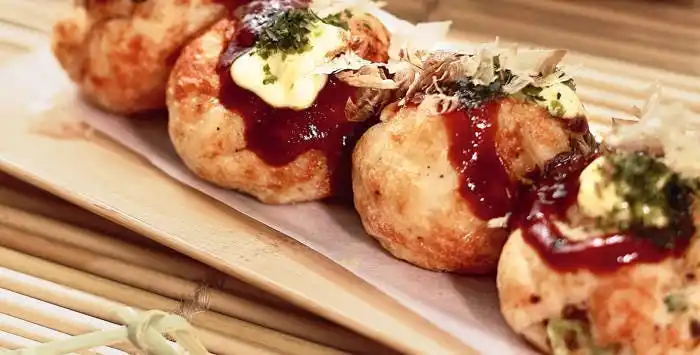
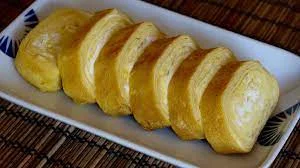
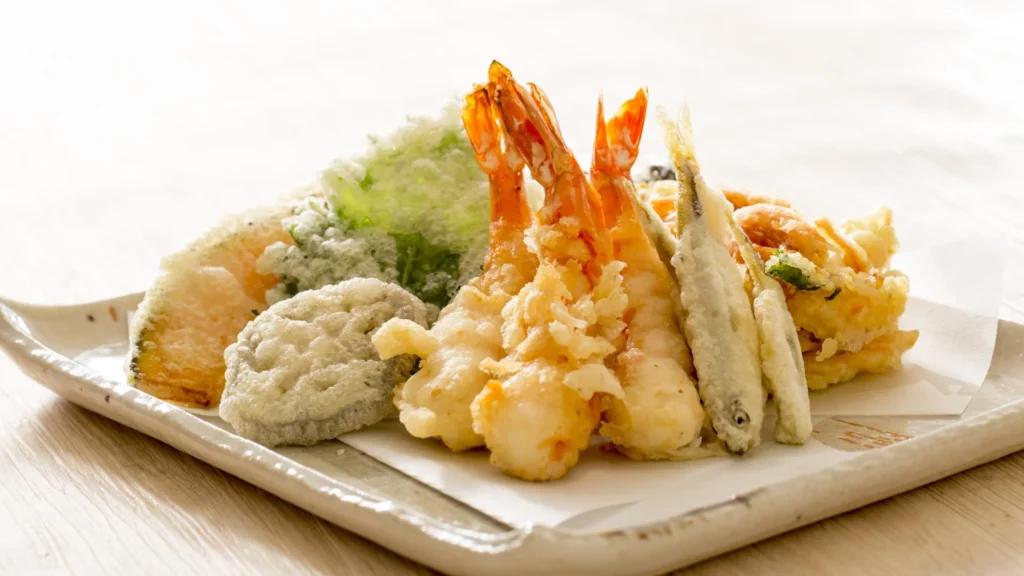
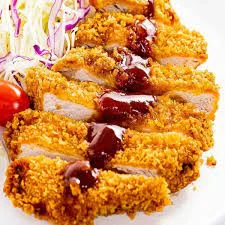
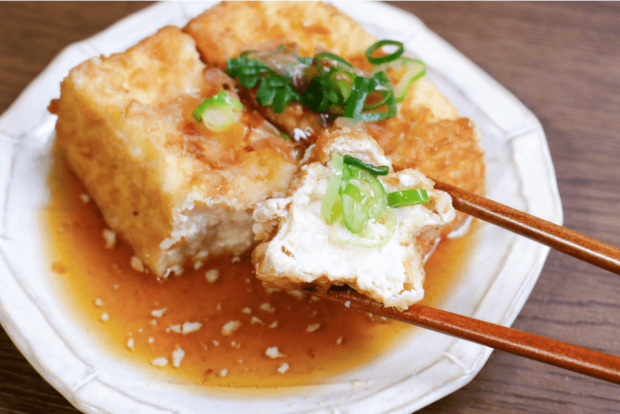
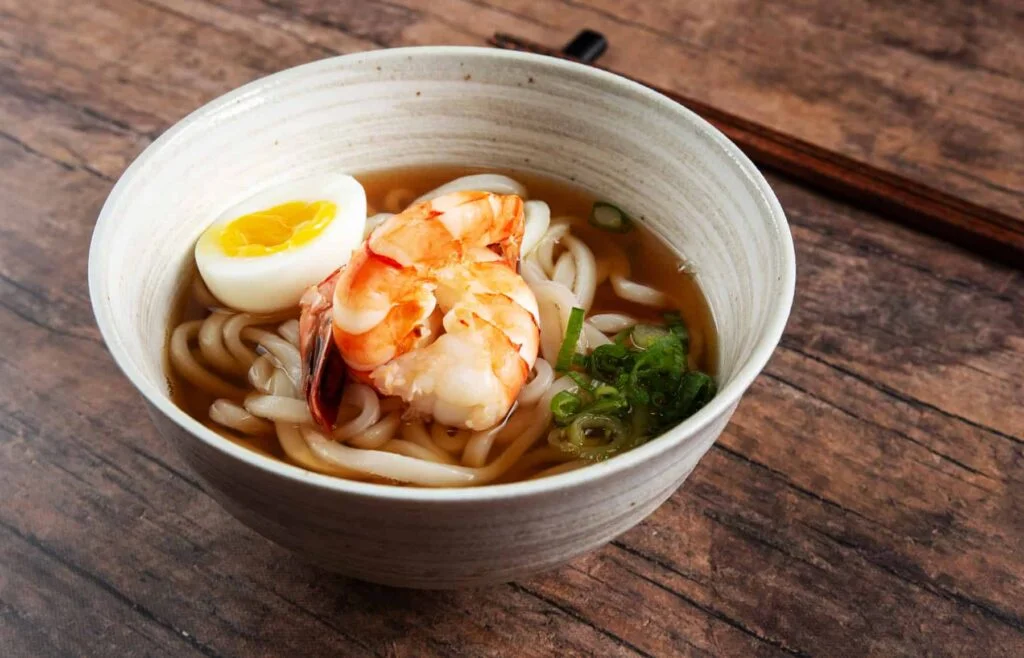
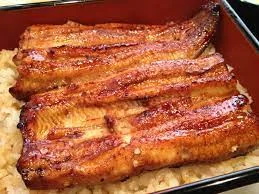
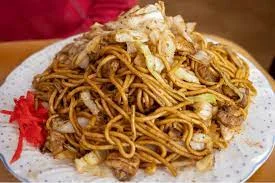
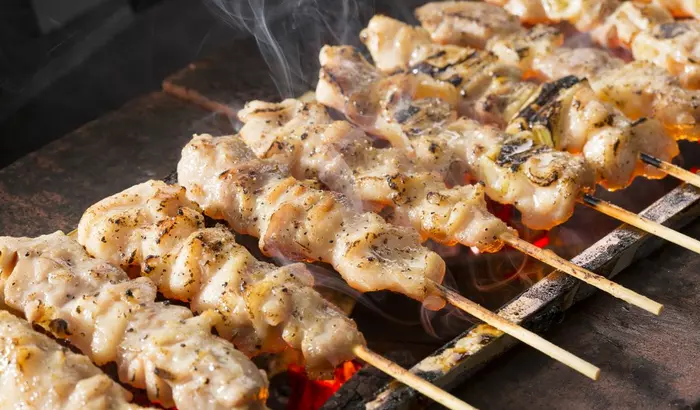
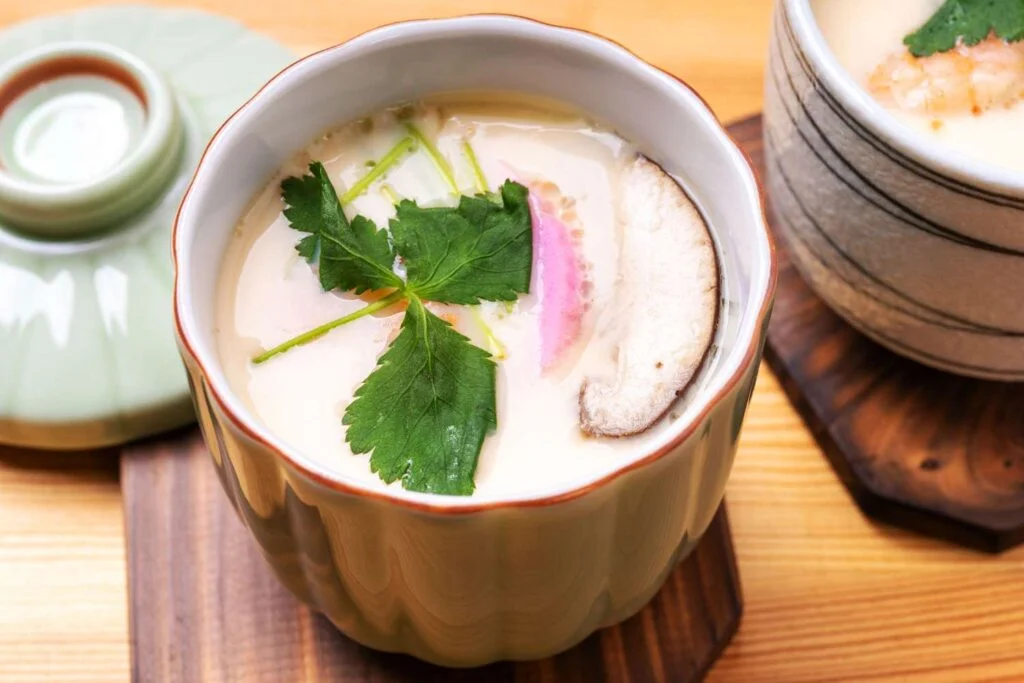

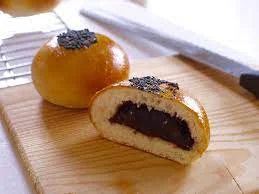
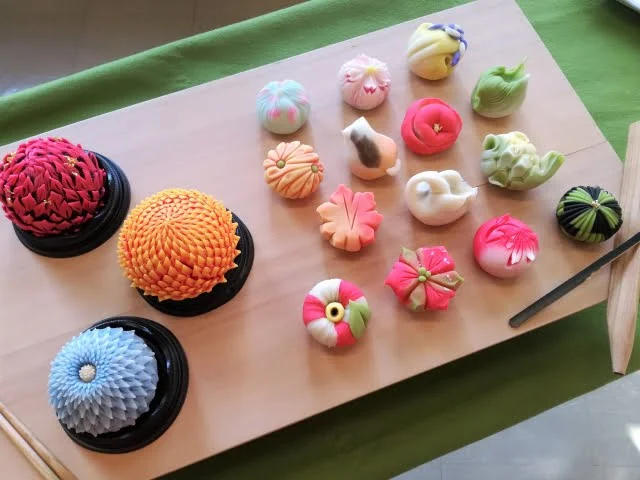
Interesting Facts About Japan
From ancient samurai traditions to quirky vending machine culture, our fascinating list of Japan facts will take you on a wild ride. Discover hidden islands, explore towering mountains, and uncover secrets buried within ancient temples.
Ready to be surprised? Buckle up and get ready to experience the true magic of Japan!
Capsule Hotels

This Japanese innovation condenses hotel rooms into small pods for efficient use of space, providing a unique lodging experience.
Robot Restaurant Shows
Tokyo’s Robot Restaurant offers futuristic dining experiences with colorful, energetic robot performances, creating a sensory overload that is both entertaining and bewildering.
Cat Cafés

Japan is renowned for its cat cafés, where patrons can enjoy a cup of coffee or tea in the company of resident felines, providing a soothing and unique atmosphere.
Purikura Photo Booths
Purikura photo booths take ordinary selfies to a new level. These booths allow users to decorate and personalize their pictures with crazy filters, backgrounds, and cute accessories, resulting in unique photo stickers.
Square Watermelons

These agriculturally crafted, square watermelons are grown to fit neatly in Japanese refrigerators. The shape doesn’t alter the taste but certainly adds a touch of novelty.
Hikikomori Phenomenon
Hikikomori refers to the social phenomenon where individuals, typically young adults, withdraw from society and isolate themselves in their homes, often fueled by societal pressures and anxiety.
KFC Christmas Tradition
KFC has become a Christmas tradition in Japan, where families often order buckets of fried chicken for festive meals. The marketing success of KFC as a Christmas treat is a unique cultural phenomenon.
Manga Cafés for Sleep
Manga cafés, or “manga kissa,” offer patrons a space to read comics, access the internet, and even take naps in private cubicles, blurring the lines between leisure and accommodation.
Fugu (Blowfish) Delicacy
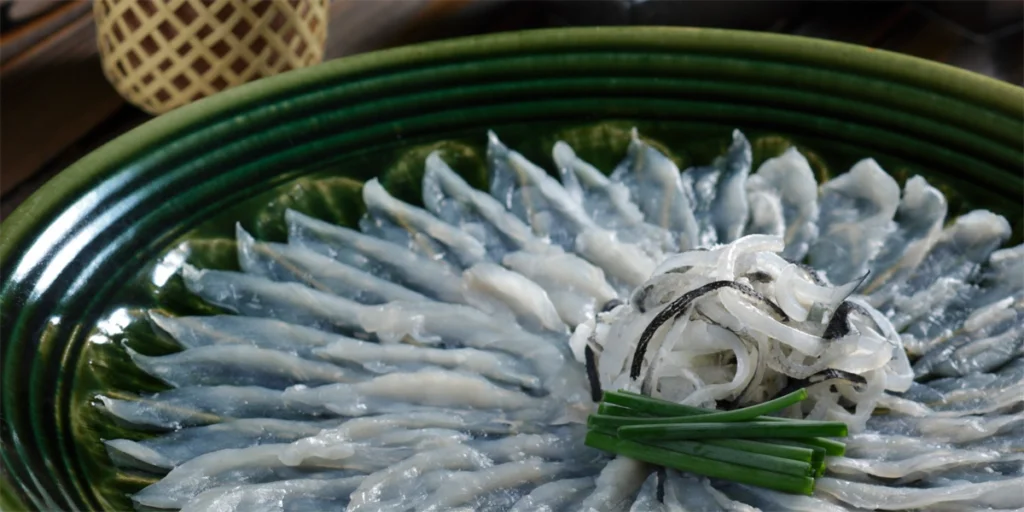
Fugu is a Japanese delicacy made from the potentially lethal blowfish. Specially trained chefs must meticulously prepare the dish, ensuring that diners enjoy the unique taste without encountering the toxic parts.
Vending Machine Variety
Japan boasts a diverse array of vending machines that dispense everything from hot meals, sake, and fresh produce to umbrellas and even underwear, showcasing the country’s love for convenience and automation.
Samurai: Warriors of Honor and Tradition

Samurai were the elite warrior class of Japan from the 12th to the late 19th century. Skilled swordsmen and masters of bushido, a strict code of honor, they held immense power and prestige. Imagine imposing figures clad in elaborate armor, wielding iconic katana swords, and fiercely loyal to their daimyo (lords).
Though their era has passed, samurai remain iconic symbols of Japanese history and culture, captivating imaginations with their tales of courage, loyalty, and unwavering discipline.
The Japan’s History and the Effect It Has Had on the Cuisine
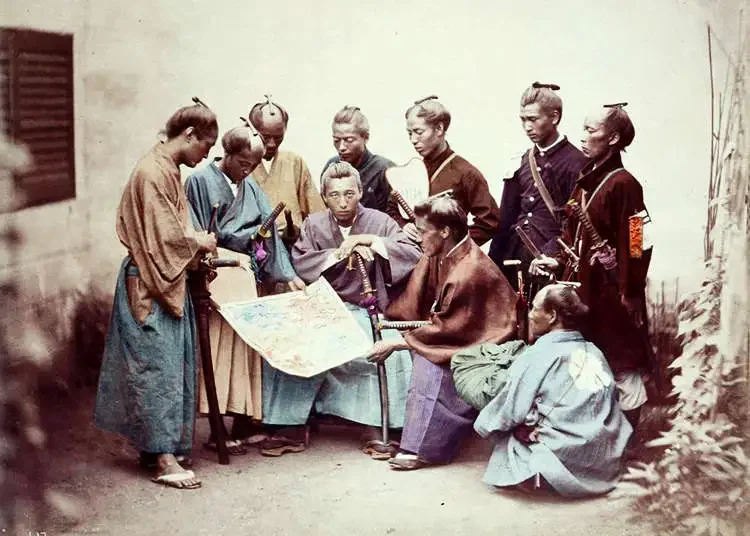
Imagine traveling through time, each bite transporting you to a different era in Japanese history. From the humble beginnings of Jomon hunters to the opulent feasts of the Edo period, Japanese cuisine boasts a rich tapestry woven through centuries of cultural shifts and influences.
Let’s embark on this delicious journey, exploring how each historical period left its unique mark on the vibrant flavors we know and love today!
Jōmon Period (-14,000 – -400 BCE): A Hunter’s Bounty
Forget supermarkets; picture our Jomon ancestors gathering wild plants, fishing in crystal-clear rivers, and hunting deer or boar. Soybeans, evidence suggests, were already part of their diet, and pottery hinted at the beginnings of culinary creativity.
Yayoi Period (400 BCE – 250 AD): Rice Takes Center Stage
A culinary revolution arrived with rice cultivation, a gift from China. This humble grain became the heart of the Japanese diet, though millet still held its place in cooler regions. Chinese influences began to peek into the kitchen, adding new flavors and techniques.
Heian Period (794-1185): The Refinement of Rice
Rice reigned supreme, even holding a special name – “Gohan” or “meshi.” Treatises and fictional tales offered glimpses into the culinary practices of the time, but actual recipes remain elusive. Imagine fragrant rice bowls and elegant presentations, staples of a refined society.
Kamakura Period (1185-1333): Buddhism and Beyond
Rice and fish continued to be the cornerstones of the diet, but a new influence emerged – Buddhism. Meat consumption became taboo, though mountain dwellers still enjoyed the occasional wild game. This period highlights the fascinating interplay between culture and cuisine.
Muromachi Period (14th-16th Century): A Feast for the Senses
“Honzen Ryori,” an elaborate ceremonial cuisine, emerged, boasting multiple courses and meticulous presentation. Vegetarian options like “Kaiseki Ryori” and “Shojin Ryori” also flourished, showcasing the growing sophistication of Japanese culinary arts.
Edo Period (17th-19th Century): Street Food & Everyday Delights
Bustling Edo (now Tokyo) saw the rise of street food stalls, offering quick and delicious meals for hungry city dwellers. Commoners’ literature documented these everyday delights, providing a window into the vibrant food culture of the period.
Meiji Period (19th-20th Century): Embracing the World
As Japan modernized, the ban on meat was lifted, opening doors to new ingredients and culinary possibilities. Western influences began to creep in, shaping a more globalized Japanese cuisine.
From humble beginnings to elaborate feasts and international influences, Japan’s culinary journey is a captivating tale of cultural exchange and innovation. Each era left its mark, shaping the flavors and techniques we enjoy today.
So, the next time you savor a steaming bowl of rice or indulge in a delicate sushi roll, remember – you’re not just enjoying a meal, you’re experiencing a rich historical legacy etched in every delicious bite.
The Second World War
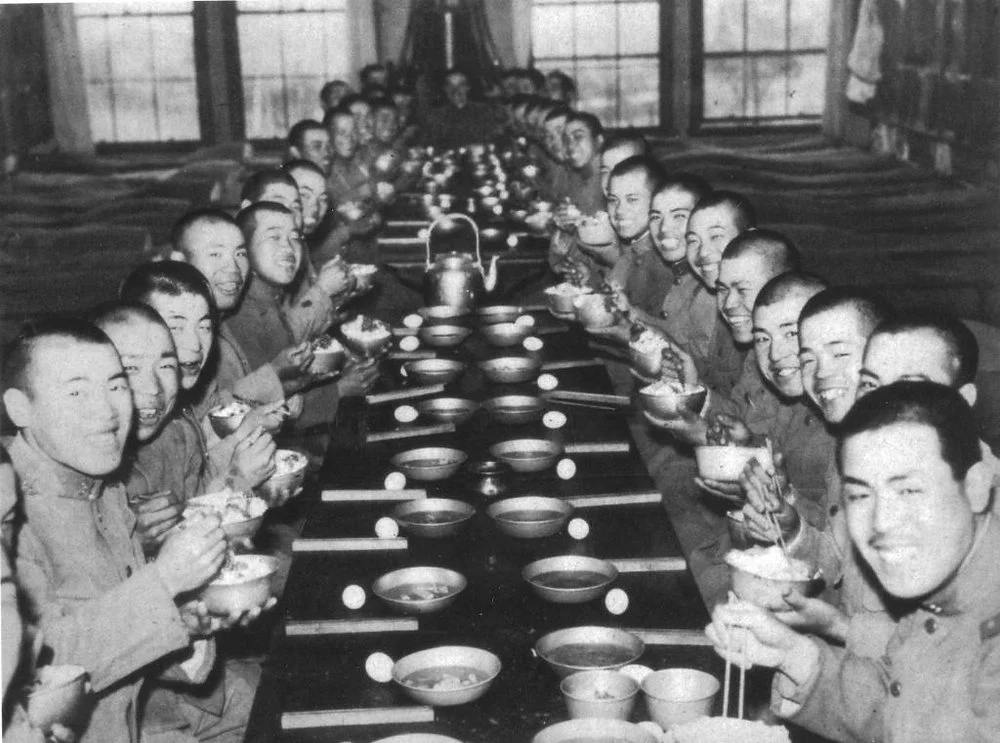
The Second World War undoubtedly impacted Japan’s cuisine, and the effects lingered for decades. Here’s a brief overview:
Immediate effects:
- Food shortages: As war priorities took over, resources and manpower shifted away from food production, leading to severe shortages of rice, meat, and other essential ingredients.
- Rationing: The government implemented strict rationing, drastically reducing calorie intake and impacting the variety of food available.
- Substitutes: People resorted to consuming less desirable substitutes like sweet potatoes and acorns to survive.
Long-term changes:
- Shifting dietary patterns: After the war, with American influence, wheat started playing a larger role in the diet, leading to increased consumption of bread and noodles.
- Protein introduction: Availability of meat and dairy products increased through American imports and aid programs, changing long-standing protein sources.
- Modernization: Food processing and convenience foods gained popularity with changing lifestyles and increased urbanization.
Lasting impacts:
- Health implications: Increased animal fat and processed food consumption contributed to rising rates of obesity and chronic diseases in later generations.
- Fusion cuisine: Exposure to Western ingredients and culinary styles gave rise to innovative fusion dishes, adapting traditional techniques to new flavors.
It’s important to note that the war’s impact on Japanese cuisine wasn’t solely negative. While it brought hardship and dietary changes, it also opened doors to new ingredients and culinary influences, contributing to the diversity and adaptability of Japanese food culture today.
References
How Japan’s Climate and Geography has Influenced Japanese food

Imagine an island nation, kissed by the ocean on all sides, its heart carved by rugged mountains. This is Japan, and its unique geography and climate have woven a story that goes beyond breathtaking landscapes – it’s a tale etched in every delicious bite of Japanese cuisine.
From Sea to Plate: A Bounty of Freshness:
Picture this: vibrant fish markets bursting with glistening tuna, delicate eel, and plump oysters – a testament to Japan’s deep connection to the sea. This abundance translates into iconic dishes like sushi and sashimi, where the ocean’s freshest offerings shine in their purest form.
Carving Culinary Magic from Mountains:
But don’t think mountains mean limitations! With ingenuity, the Japanese mastered terraced farming, carving verdant steps into steep slopes to nurture their beloved rice. This humble grain, cultivated with meticulous care, forms the very soul of Japanese cuisine, holding both cultural and economic significance.
Seasons Painted on Your Plate:
Blessed with a warm, monsoon climate, Japan enjoys distinct seasons, each reflected in its food. Spring awakens with fragrant sakura blossoms, inspiring delicate dishes. Autumn explodes with rich colors, bringing forth sweet persimmons and earthy chestnuts. This deep appreciation for seasonality ensures every meal is a celebration of nature’s bounty.
Fermentation: A Flavorful Legacy:
Japan’s humid climate fostered the art of fermentation, resulting in umami-rich treasures like miso and soy sauce. These versatile ingredients add depth and complexity to countless dishes, showcasing the creativity and resourcefulness of Japanese cuisine.
A Feast of Influences:
Japan’s geographical location also played a key role in shaping its culinary tapestry. Ramen and udon noodles, adopted from China, now boast uniquely Japanese flavors. Tempura, brought by Portuguese traders, found a permanent home in the hearts (and stomachs) of the Japanese people.
Spiritual Gastronomy:
Religion too, has left its mark. Buddhism’s emphasis on vegetarianism led to the development of shojin ryori, temple cuisine characterized by simplicity and natural flavors. Shintoism’s reverence for certain animals influences food choices, adding another layer to the fascinating story of Japanese food.
From Coastline to Mountaintop, a Culinary Harmony:
From the freshest seafood to perfectly cooked rice, every element of Japanese cuisine reflects the land that nurtured it. The mountains may limit space, but they also cultivate ingenuity. The seasons may change, but they offer a constantly evolving canvas for culinary artistry. It’s in this harmonious dance between geography, climate, and culture that Japan’s truly unique and delicious food tradition is born.
Understanding the Essence of Japanese food
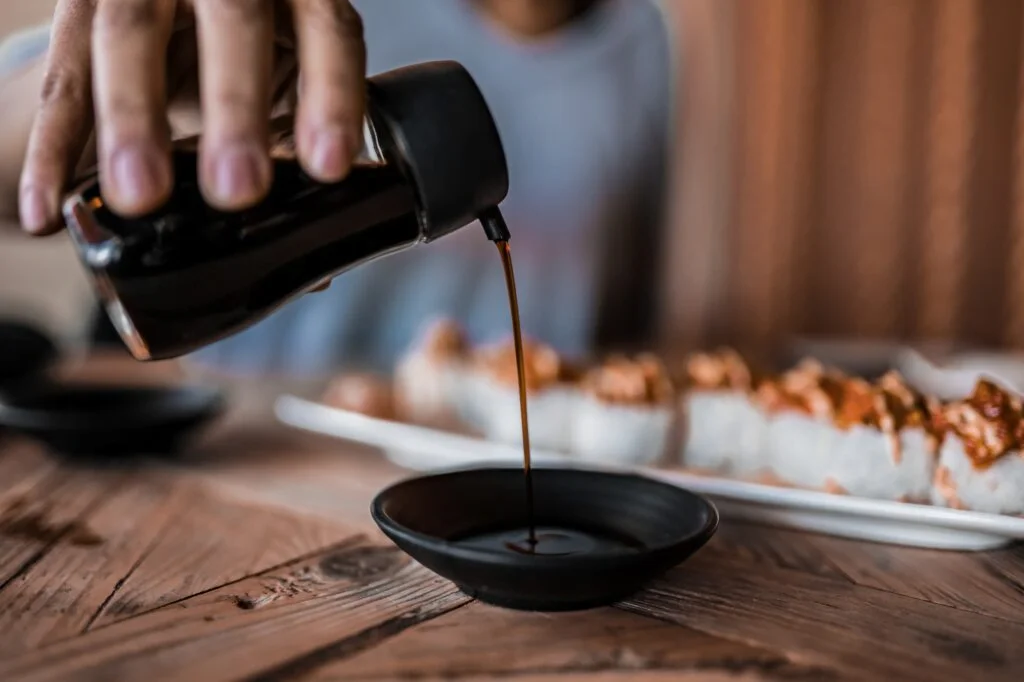
The essence of Japanese cuisine lies in its simplicity and respect for ingredients. The Japanese philosophy of cooking, “ichiju-sansai”
Japanese cuisine, often lauded for its delicate dishes and refined presentation, boasts a soul deeper than any single food or trend. While sushi and ramen may be prominent faces on the global stage, the true essence of Japanese food lies in a captivating dance between freshness, seasonality, simplicity, and cultural influences.
Nature’s Bounty on Your Plate:
Imagine steaming bowls of rice, vibrant with the aromas of different seasons. Rice, the “heart” of Japanese cuisine, forms the canvas upon which other ingredients like fresh seafood, seasonal vegetables, and fermented delights play their parts.
This deeply ingrained connection to nature ensures dishes are as seasonally specific as they are delicious. Spring brings bamboo shoots and sakura-infused sweets, while autumn’s harvest yields earthy mushrooms and chestnuts.
This respect for seasonality not only guarantees the freshest flavors but also imbues each meal with a unique sense of time and place.
Simplicity with Umami Depth:
Don’t be fooled by the seemingly minimalist presentations. Japanese culinary philosophy embraces “less is more,” allowing the inherent flavors of each ingredient to shine. Techniques like grilling, simmering, and steaming gently coax out the best of each element, creating a symphony of subtle tastes and textures. Yet, simplicity doesn’t equate to blandness.
The skillful use of umami-rich ingredients like miso, soy sauce, and dashi broth adds complexity and depth, ensuring each bite is an explosion of deliciousness.
A Harmony of Tradition and Innovation:
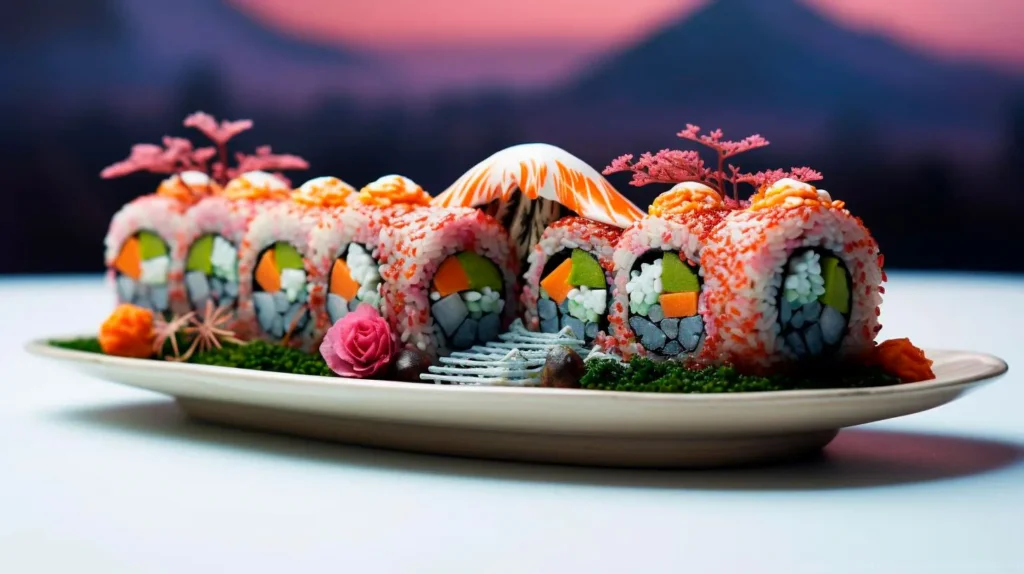
While acknowledging its ancient roots, Japanese cuisine is never stagnant. New techniques and influences are readily absorbed, seamlessly woven into the existing culinary tapestry.
From embracing foreign dishes like ramen to developing modern takes on classics like sushi, Japan showcases a remarkable ability to innovate while staying true to its heritage.
This cultural openness ensures the cuisine remains vibrant and relevant, constantly evolving while respecting its past.
Beyond the Food: A Cultural Lens:
To truly understand the essence of Japanese food, one must look beyond the plate. It’s intricately linked to cultural values like aesthetic appreciation, respect for nature, and community spirit.
The meticulous presentation reflects the Japanese emphasis on beauty, while the communal nature of many meals signifies the importance of social connection.
The act of preparing and sharing food becomes a way to connect with family, friends, and even ancestors, strengthening the social fabric of the community.
In Conclusion:
The essence of Japanese cuisine lies not in individual dishes but in the holistic experience it offers. It’s a tapestry woven from fresh, seasonal ingredients, prepared with simplicity and respect for tradition, yet open to innovative influences.
More than just sustenance, it’s a window into Japanese culture, reflecting its values, aesthetics, and deep connection to nature. So, the next time you savor a Japanese meal, remember, you’re not just enjoying a delicious dish; you’re embarking on a cultural journey with every bite.
(one soup, three sides), emphasizes balance and nutrition, typically featuring a soup, rice, and three dishes.
Presentation is as important as taste, with an emphasis on seasonal garnishes and artful arrangement. The cuisine is also characterized by its variety of cooking techniques, from raw (sashimi) to fermented (miso), and a preference for umami flavors, achieved through the use of ingredients like soy sauce and dashi.
How Healthy is Japanese Food?

The heart of Japanese health lies in “washoku,” the traditional Japanese diet.
A Feast for Body and Soul
Washoku celebrates nature’s bounty. Think fresh fish swimming from the sea to your plate, vibrant veggies bursting with vitamins, and fluffy rice cultivated with care. This isn’t just delicious; it’s packed with lean protein, fiber, and essential nutrients.
But it’s not just about what’s on the plate; portion control and mindful eating are key. Small, beautifully presented dishes encourage savoring every bite, promoting moderation and healthy habits.
Umami: The Flavor of Health
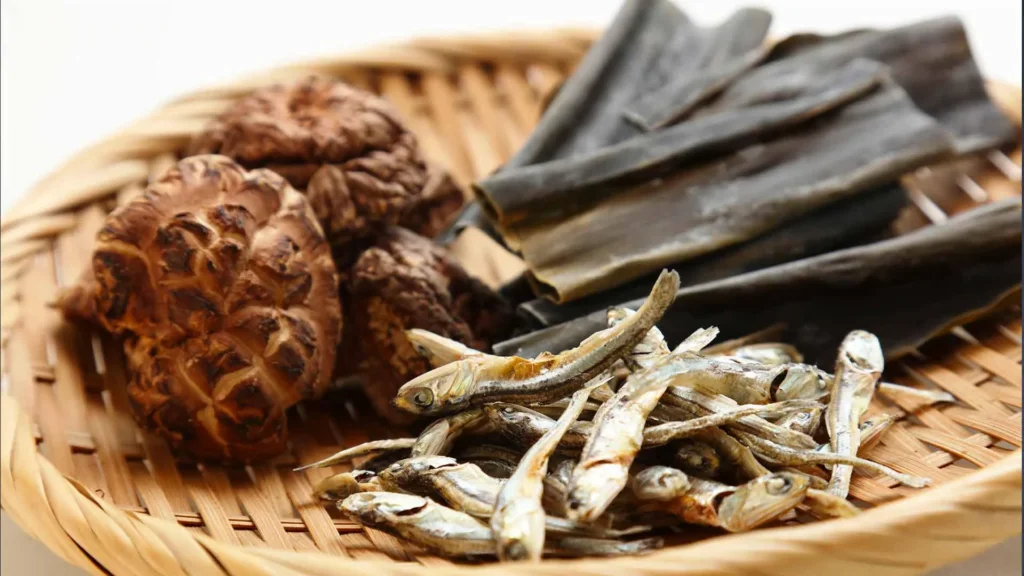
Beyond aesthetics, Japanese cuisine excels in the realm of umami, a savory taste associated with nutrient-rich foods like mushrooms and seaweed. This unique flavor experience not only tantalizes the taste buds but also promotes satiety, helping you feel fuller for longer.
Fermented Delights for a Happy Gut
Japan embraces ancient wisdom through fermented foods like miso and soy sauce. These gut-friendly wonders support a healthy microbiome, essential for overall well-being and digestion.
The Proof is in the Numbers
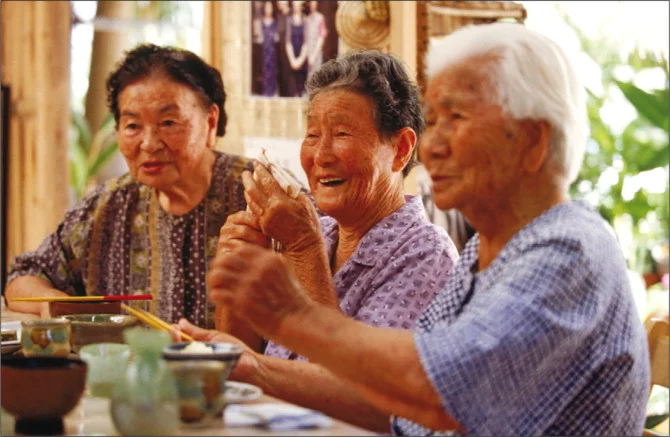
The results speak for themselves. Japan boasts one of the highest life expectancies globally, with individuals enjoying active and healthy lives well into their golden years.
Low obesity rates and effective management of chronic diseases further highlight the positive impact of their dietary choices.
Looking Beyond the Plate
However, the story isn’t solely about food. Active lifestyles, a strong emphasis on community support, and accessible healthcare contribute to Japan’s exceptional health outcomes.
But don’t just read; explore! Discover the culinary wonders of washoku, embrace mindful eating practices, and unlock the secrets of Japan’s health magic. Remember, your well-being journey starts on your plate – savor every bite and savor a healthier you!
References
- healthline.com
- japantruly.com
- statista.com
- data.who.int
- oecd.org
- weforum.org
- whysojapan.com
- fitsianfoodlife.com
- wapititravel.com
Traditional Japanese Food

Traditional Japanese Food is deeply rooted in the concept of harmony and seasonality. Rituals like the tea ceremony and kaiseki dining showcase the meticulous preparation and presentation of food, reflecting a culture that finds beauty in subtlety and detail.
Meals are often enjoyed communally, with shared dishes and an emphasis on etiquette. Festivals and holidays are celebrated with special foods like mochi for New Year and moon-viewing dango during autumn, each dish imbued with meaning and history.
Exploring the Japanese Ingredients: The Flavors of Japan

The flavors of Japan are a testament to the country’s rich natural bounty and the culinary ingenuity of its people. Key ingredients include:
- Rice: The staple of Japanese meals, often served as plain steamed rice or sushi.
- Seafood: A cornerstone of the diet, consumed fresh, dried, smoked, or fermented.
- Soy: Used in various forms such as tofu, soy sauce, miso, and natto.
- Seaweed: Varieties like nori, wakame, and kombu are used for flavor and nutrition.
- Vegetables: Both cultivated and wild, including daikon, shiitake mushrooms, and bamboo shoots.
- Green Tea: Consumed daily, it’s integral to Japanese culture and cuisine.
- Seasonings: Subtle and varied, from vinegar and wasabi to mirin and sake.
These ingredients are the building blocks of a cuisine that is at once ancient and contemporary, simple and complex, and always in harmony with nature’s ebb and flow.
Japan Cuisine – The Art of Sushi-Making

Sushi is more than just a dish; it’s an art form. Whether you prefer nigiri, maki rolls, or sashimi, sushi is a cornerstone of Japanese cuisine and a beloved culinary tradition worldwide.
At its core, sushi is a simple dish made from a few key ingredients: rice, fish, and vinegar. But the nuances of creating delicious and visually stunning sushi require years of practice and dedication.
One of the secrets to great sushi is using fresh, high-quality ingredients. Sushi chefs carefully select the fish and seafood they use, taking into account factors like seasonality, flavor, and texture. They also pay meticulous attention to the rice, using specific types of rice and vinegar to achieve the desired consistency and flavor.
When it comes to sushi-making techniques, precision is key. Sushi chefs must master the art of handling the ingredients, shaping the rice, and slicing the fish to create perfectly balanced and visually appealing sushi. They also use a range of tools, from bamboo mats to special knives, to ensure that each piece of sushi is crafted with care.
Sushi-making is a deeply ingrained part of Japanese culture, and there are many customs and traditions associated with it. For example, it’s considered impolite to mix wasabi into soy sauce, as this can affect the delicate balance of flavors in the sushi. Instead, wasabi should be added directly to the sushi before eating.
Overall, sushi-making is a fascinating and rewarding art form. Whether you’re a seasoned sushi connoisseur or just starting to discover the joys of Japanese cuisine, sushi is a dish that is sure to delight and inspire.
National Dish of Japan – Sashimi – A Raw Delight
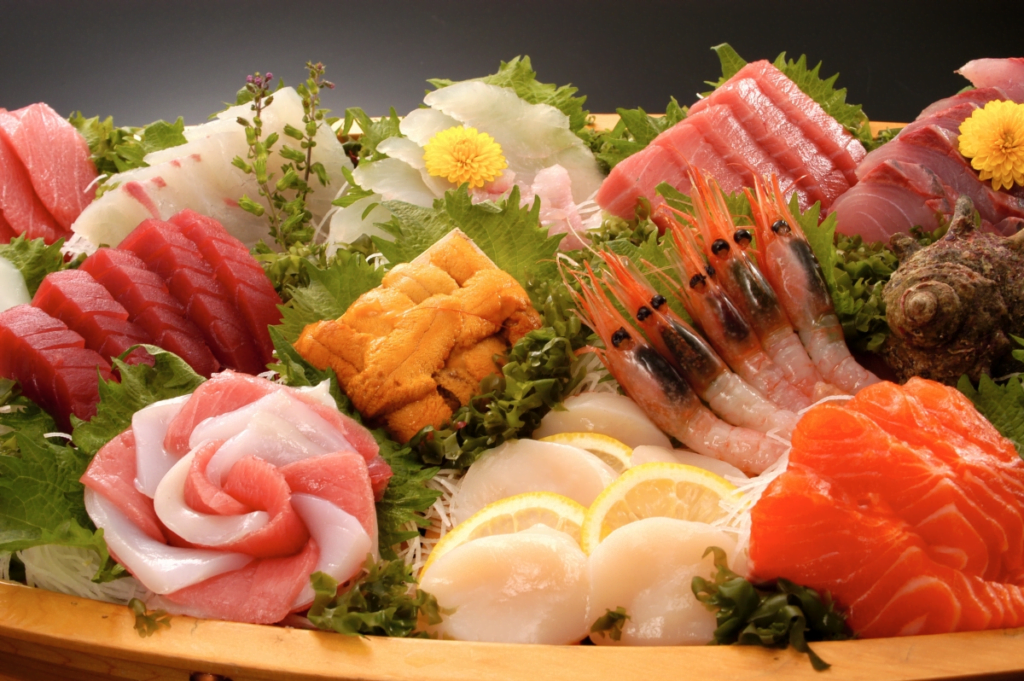
When it comes to traditional Japanese dishes, sashimi is a true masterpiece. Served raw and sliced thinly, sashimi showcases the pure flavors of the seafood used in the dish. The dish is typically accompanied by soy sauce, wasabi, and ginger, which complement and enhance the delicate flavors of the fish.
The most commonly used fish for sashimi includes tuna, salmon, and yellowtail, but other seafood such as octopus, squid, and shrimp can also be used. One important factor for sashimi is the freshness of the fish. In Japanese cuisine, freshness is highly valued, and sashimi is no exception. Traditionally, the fish is served on a bed of ice to ensure that it remains fresh and safe to eat.
Aside from the delicious flavors, sashimi also holds cultural significance in Japan. The dish is often served at celebrations and special occasions, symbolizing the importance of fresh, high-quality ingredients and impeccable presentation in Japanese cuisine.
When enjoying sashimi, it’s essential to follow proper etiquette. Sashimi is typically eaten with chopsticks, and it’s important to take small bites to fully appreciate the flavors. It’s also common to dip the sashimi into the soy sauce and wasabi mixture before eating.
Overall, sashimi is a true delight for seafood lovers and a hallmark of Japanese cuisine. Its elegant simplicity and emphasis on freshness make it a dish that is both delicious and culturally significant.
The key to great sashimi is the freshness and quality of the fish. Here’s a basic guide to preparing sashimi:
National Dish of Japan – Sashimi – Ingredients:
- Fresh fish or seafood (common choices include tuna, salmon, yellowtail, shrimp, scallops, and octopus)
- Wasabi (Japanese horseradish)
- Soy sauce
- Pickled ginger (Gari)
- Optional: Freshly grated daikon radish
Preparation Instructions:
Selecting the Fish
- It’s crucial to use sashimi-grade fish, which is the highest quality and has been handled and prepared with raw consumption in mind. Purchase from a reputable fishmonger or specialty store.
- The fish should smell fresh, not fishy. The flesh should be firm, moist, and translucent.
Preparing the Fish
- Begin by cleaning and gutting the fish if it hasn’t been done already.
- Remove any skin, bones, and undesirable parts from the fish.
- Using a very sharp knife (a sashimi knife is ideal, but any sharp knife will do), slice the fish. The thickness of the slices depends on the type of fish and personal preference but is typically between 1/8 to 1/4 inch.
- For fish like tuna and salmon, cut against the grain into broad, flat slices.
- For shrimp, remove the head, shell, and vein. You can lightly poach them or serve them raw.
- For octopus, it’s typically boiled until tender before being thinly sliced.
Serving
- Arrange the slices neatly on a chilled plate. It’s common to place them on a bed of thinly sliced daikon radish for aesthetics and a refreshing crunch.
- Serve with a small amount of wasabi on the side. Some people like to mix wasabi with soy sauce, while others prefer to place a tiny amount on a piece of sashimi and then dip it into soy sauce.
- Pickled ginger is also served on the side. It’s used as a palate cleanser between different types of sashimi.
- Pour a small amount of soy sauce into a dish for dipping. Remember, the goal is to lightly flavor the sashimi, not overpower it, so use sparingly.
Eating
- Use chopsticks to pick up a piece of sashimi, dip it lightly in the soy sauce (with or without wasabi), and enjoy. Between different types of sashimi, eat a piece of pickled ginger to cleanse your palate.
Tips:
- Always handle raw fish with clean hands and utensils to prevent contamination.
- If you’re unsure about the freshness of the fish, it’s better to err on the side of caution and not consume it raw.
- Sashimi is often enjoyed with a glass of sake or cold beer.
Enjoy your sashimi, a true representation of the beauty of simplicity in Japanese cuisine!
Japanese Cuisine – Ramen – The Comforting Bowl of Goodness

When it comes to Japanese cuisine, ramen is one of the most beloved dishes. This comforting bowl of goodness is a staple in Japan, and its popularity has spread worldwide.
Originating in China, ramen has become a quintessential part of Japanese food culture. Its humble origins as a cheap and easy meal have evolved into a diverse range of regional variations that showcase the deep flavors and unique ingredients of Japanese cuisine.
At its core, ramen is a simple dish: wheat noodles served in a flavorful broth and topped with an assortment of meats, vegetables, and seasonings. But the combinations are endless, making each bowl a unique experience.
The broth is a critical component of the dish, and it can take hours to prepare, simmered with ingredients such as pork bones, chicken, or seafood to create a rich umami flavor. Types of broth include miso, shoyu, and tonkotsu, each with its own distinct taste.
The noodles themselves are also essential. Thin and springy, they are often made fresh and can vary in thickness and texture depending on the region. Some popular toppings can include chashu (braised pork belly), soft-boiled eggs, seaweed, and green onions.
Whether enjoyed in a bustling ramen restaurant or made at home, a bowl of ramen is a comforting and satisfying meal that captures the essence of Japanese cuisine.
So if you’re looking to explore traditional Japanese dishes, be sure to add ramen to your list. With its warm broth, chewy noodles, and delicious toppings, it’s sure to become a favorite.
There are many regional variations of ramen, but here’s a basic recipe for a classic soy sauce-flavored (shoyu) ramen:
Japanese Cuisine – Ramen Ingredients:
For the Broth:
- 1 chicken carcass or 2-3 pounds chicken bones
- 1 pork bone (optional for added depth)
- 1 onion, halved
- 2-3 garlic cloves, crushed
- 1 small piece of ginger, sliced
- 10 cups water
- 2 tablespoons soy sauce
- 1 tablespoon sake
- 1 teaspoon sugar
- Salt to taste
For the Toppings:
- 2-3 slices of chashu (braised pork belly or pork loin)
- 2 boiled eggs, halved (soft-boiled or marinated eggs are preferred)
- 2-3 green onions, sliced
- Nori (dried seaweed) sheets
- Bamboo shoots (menma)
- Bean sprouts, blanched
- Corn kernels
- Spinach or bok choy, blanched
Other:
- Ramen noodles (fresh or dried)
- Optional: sesame oil, chili oil, or other flavored oils for seasoning
Preparation Instructions:
Making the Broth
- In a large pot, add the chicken bones, pork bone (if using), onion, garlic, and ginger. Cover with water.
- Bring the mixture to a boil, then reduce the heat to a simmer. Skim off any impurities or foam that rises to the surface.
- Allow the broth to simmer for 3-4 hours. The longer it simmers, the richer the flavor will be.
- Strain the broth to remove the bones and solids. Return the clear broth to the pot.
- Season the broth with soy sauce, sake, sugar, and salt. Adjust the seasoning according to your taste.
Preparing the Toppings
- While the broth is simmering, you can prepare your toppings. Cook the chashu, boil the eggs, slice the green onions, and prepare any other desired toppings.
Cooking the Noodles
- In a separate pot, bring water to a boil. Cook the ramen noodles according to the package instructions until al dente.
- Drain the noodles and set them aside. It’s best to cook the noodles when you’re ready to serve so they remain fresh and chewy.
Assembling the Ramen
- In individual serving bowls, ladle the hot broth.
- Add the cooked ramen noodles to the broth.
- Arrange the toppings over the noodles: chashu slices, boiled egg halves, green onions, nori, bamboo shoots, and any other desired toppings.
- Optionally, drizzle with a bit of flavored oil like sesame oil or chili oil for added flavor.
Serving
- Serve the ramen hot with chopsticks and a spoon. Enjoy immediately for the best texture and flavor.
Tips:
- The broth is the heart of the ramen, so take your time with it. Some ramen broths are simmered for even longer durations, sometimes over 10 hours, to extract maximum flavor.
- There are various types of ramen, including miso ramen, tonkotsu ramen (pork bone broth), and more. Each has its unique preparation method and flavor profile.
- Fresh ramen noodles are ideal, but good quality dried ramen noodles can also be used.
Enjoy your homemade ramen, a comforting and flavorful bowl of Japanese goodness!
Tempura, Takoyaki, and More – Exploring Japanese Street Food
One of the best ways to immerse yourself in the vibrant culinary culture of Japan is to explore its street food scene. From crispy tempura to savory takoyaki, the array of flavors and textures will tantalize your taste buds and leave you craving more.
Japanese Cuisine – Tempura
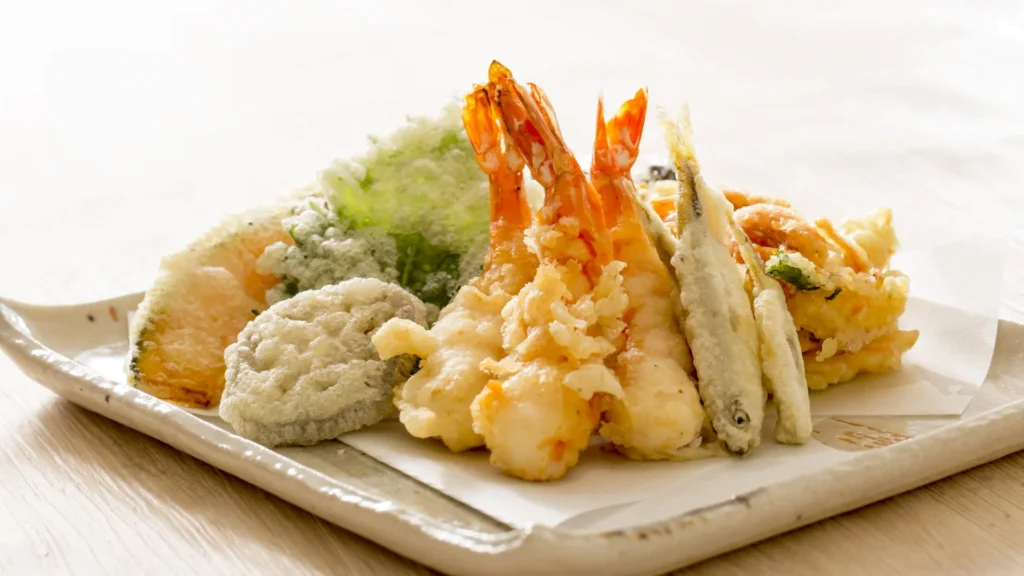
Tempura is a beloved Japanese dish that consists of battered and fried seafood or vegetables. The batter is made with a mix of wheat flour, water, and sometimes egg and is traditionally served with tentsuyu sauce. Some popular tempura ingredients include shrimp, squid, sweet potato, eggplant, and green beans.
Here’s a recipe for making traditional tempura:
Japanese Cuisine – Tempura Ingredients:
For the Tempura:
- Assorted vegetables (such as bell peppers, sweet potatoes, zucchini, mushrooms, and broccoli)
- Seafood options (such as shrimp, squid, and white fish fillets)
- Oil for frying (vegetable or canola oil)
The Batter:
- 1 cup all-purpose flour
- 1 egg
- 1 cup ice-cold water
- Optional: 1/2 teaspoon baking powder (for extra crispiness)
- Ice cubes
For the Dipping Sauce (Tentsuyu)
- 1 cup dashi (Japanese soup stock)
- 1/4 cup soy sauce
- 1/4 cup mirin (sweet rice wine)
- 1-2 green onions, finely chopped
- Grated daikon radish (optional)
Preparation Instructions
Preparing the Ingredients
- Clean and peel the vegetables and seafood.
- Cut the vegetables into bite-sized pieces or strips.
- For shrimp: Devein and remove the shell, leaving the tail intact. Make small cuts on the underside to straighten them.
Making the Batter
- In a mixing bowl, lightly beat the egg.
- Add the ice-cold water to the egg and mix.
- Sift the flour (and baking powder if using) into the bowl. Gently mix the ingredients, being careful not to overmix. It’s okay if there are a few lumps.
- Keep the batter cold by placing the bowl in a larger bowl filled with ice cubes.
Frying the Tempura
- Heat the oil in a deep frying pan or pot to 340-360°F (170-180°C). You can test the temperature by dropping a small amount of batter into the oil. If it sinks a little and then immediately rises to the surface, the oil is ready.
- Dip the vegetables and seafood into the batter, ensuring they’re well-coated.
- Carefully drop the coated ingredients into the hot oil. Fry them in batches to avoid overcrowding.
- Fry until the tempura is golden and crispy, turning the pieces occasionally.
- Remove the tempura from the oil and drain on paper towels.
Making the Dipping Sauce (Tentsuyu)
- In a saucepan, combine the dashi, soy sauce, and mirin. Bring to a boil, then reduce the heat and let it simmer for a couple of minutes.
- Remove from heat and allow it to cool to room temperature.
- Serve the sauce in small bowls, garnished with chopped green onions and optional grated daikon.
Serving
- Serve the tempura hot with the dipping sauce on the side. Enjoy immediately for the best texture and flavor.
Tips:
- Keeping the batter cold is crucial for achieving the light and crispy texture of tempura.
- Do not overmix the batter, as this can make the tempura heavy and less crispy.
- Adjust the frying temperature based on the ingredients. Root vegetables might need slightly lower temperatures, while leafy vegetables and seafood might need higher temperatures.
Enjoy your homemade Japanese tempura, a delightful combination of crispy batter and tender ingredients!
27 more recipes you can try at home
Convinced? Check out the following recipes that we have carefully selected that can be prepared in the Confort of your own kitchen,
Japanese Food – Takoyaki

Takoyaki is a popular Japanese street food that originated in Osaka. These savory ball-shaped snacks are made with a batter of wheat flour, dashi, and eggs, and filled with diced octopus, green onion, and pickled ginger. They are typically served with takoyaki sauce, mayonnaise, and bonito flakes.
Here’s a recipe for making traditional takoyaki:
Japanese Food – Takoyaki Ingredients:
For the Batter:
- 2 cups all-purpose flour
- 2 teaspoons baking powder
- 1/2 teaspoon salt
- 2 eggs
- 2 1/2 cups dashi (Japanese soup stock)
For the Filling:
- 1/2 pound boiled octopus, cut into small pieces
- 4 green onions, finely chopped
- 1/4 cup pickled ginger, finely chopped
- 1/4 cup tempura scraps (tenkasu)
Toppings:
- Takoyaki sauce (similar to Worcestershire sauce but thicker and sweeter)
- Mayonnaise
- Dried bonito flakes (katsuobushi)
- Green laver (aonori)
Equipment:
- Takoyaki pan
Preparation Instructions:
Preparing the Batter
- In a mixing bowl, sift together the flour, baking powder, and salt.
- In another bowl, whisk the eggs and add the dashi. Mix well.
- Gradually add the wet ingredients to the dry ingredients, whisking continuously until you have a smooth batter. The consistency should be similar to pancake batter.
Cooking the Takoyaki
- Preheat the takoyaki pan and brush it with oil to prevent sticking.
- Pour the batter into the takoyaki pan, filling each hole almost to the top.
- Drop octopus pieces, green onions, pickled ginger, and tempura scraps into each hole.
- Once the bottom of the takoyaki becomes golden brown, use a skewer or chopstick to turn each ball 90 degrees, tucking in the batter that spills out. This will create a round shape.
- Continue cooking, turning the balls frequently until they are crispy on the outside and cooked through.
Serving
- Place the cooked takoyaki on a plate.
- Brush them with takoyaki sauce and drizzle with mayonnaise.
- Sprinkle with dried bonito flakes and green laver.
- Serve hot and enjoy!
Tips:
- The key to perfect takoyaki is to keep turning them for an even, golden-brown crust.
- Takoyaki pans are available online or in Japanese kitchenware stores. If you don’t have a takoyaki pan, you can use an æbleskiver pan as an alternative.
- You can experiment with different fillings based on your preferences, such as cheese, shrimp, or even sweet fillings for a dessert version.
Enjoy your homemade Takoyaki, a savory and delicious Japanese treat that’s crispy on the outside and soft on the inside!
Japanese Food – Okonomiyaki

Okonomiyaki is a savory pancake-like dish that is popular throughout Japan. The batter is made with flour, eggs, and shredded cabbage, and grilled with a variety of savory ingredients such as bacon, shrimp, and octopus. Okonomiyaki is typically topped with okonomi sauce, mayonnaise, and aonori seaweed flakes.
Here’s a recipe for the Kansai-style okonomiyaki:
Japanese Food – Okonomiyaki Ingredients
For the Batter:
- 1 cup all-purpose flour
- 3/4 cup dashi (Japanese soup stock) or water
- 1 teaspoon baking powder
- 1/4 teaspoon salt
- 4 eggs
- 4 cups finely shredded cabbage
- 4 green onions, finely chopped
- Optional protein: thinly sliced pork belly, shrimp, or squid
Additional Ingredients:
- Okonomiyaki sauce (available at Japanese grocery stores or you can use a mix of Worcestershire sauce, ketchup, and soy sauce)
- Mayonnaise
- Dried bonito flakes (katsuobushi)
- Dried seaweed powder (aonori)
- Pickled ginger (beni shoga)
Preparation Instructions:
Preparing the Batter
- In a large mixing bowl, combine the flour, dashi or water, baking powder, and salt. Whisk until smooth.
- Add the eggs to the batter and mix well.
- Fold in the shredded cabbage, green onions, and your choice of protein.
Cooking the Okonomiyaki
- Heat a large skillet or griddle over medium heat and add a bit of oil.
- Pour a portion of the batter onto the skillet, shaping it into a round pancake about 1/2-inch thick.
- If using pork belly slices, place them on top of the pancake.
- Cook for about 3-4 minutes until the bottom is golden brown.
- Flip the okonomiyaki and cook for another 3-4 minutes on the other side. If you’ve added pork belly, this side should be crispy and golden.
- Flip once more and cook for another 2 minutes to ensure the inside is cooked through.
Serving
- Transfer the cooked okonomiyaki to a plate.
- Brush the top with okonomiyaki sauce and drizzle with mayonnaise in a zigzag pattern.
- Sprinkle with dried bonito flakes, dried seaweed powder, and add some pickled ginger on the side.
- Serve hot.
Tips:
- Okonomiyaki is highly customizable. You can add other ingredients like cheese, corn, or other vegetables based on your preferences.
- Some regions in Japan, like Hiroshima, have their unique style of okonomiyaki, which involves layering ingredients rather than mixing them into the batter.
- A special spatula called “okonomiyaki hera” can be used to flip the pancake easily, but a regular spatula works just fine.
Enjoy your homemade okonomiyaki, a flavorful and filling Japanese dish that’s both fun to make and delicious to eat!
Japanese Cuisine – Kare Pan

Kare Pan, or curry bread, is a delicious Japanese snack that is perfect for a quick bite on the go. It consists of a breaded and deep-fried dough filled with curry sauce and sometimes a meat or vegetable filling. Kare Pan is typically sold at bakeries and convenience stores throughout Japan.
Japanese street food is a delicious and affordable way to experience the unique flavors and ingredients of Japanese cuisine. Whether you prefer savory or sweet, there is something for every palate. So grab a friend and hit the streets to explore the culinary delights of Japan.
Here’s a basic recipe for Kare Pan:
Japanese Cuisine – Kare Pan Ingredients
The Curry Filling:
- 200g ground beef or pork
- 1 small onion, finely chopped
- 1 carrot, finely chopped
- 2 cloves garlic, minced
- 1 tablespoon oil
- 2 tablespoons curry powder
- 1 tablespoon flour
- 200ml water or beef/chicken broth
- 2 tablespoons Worcestershire sauce
- 1 tablespoon ketchup
- Salt and pepper to taste
For the Bread:
- 250g bread flour
- 5g salt
- 25g sugar
- 5g dry yeast
- 150ml warm water
- 25g unsalted butter, softened
For Frying:
- 1 egg (for egg wash)
- Breadcrumbs
- Oil for deep frying
Preparation Instructions:
Curry Filling:
- In a pan, heat oil over medium heat. Add onions, carrots, and garlic. Sauté until onions are translucent.
- Add the ground meat and cook until browned.
- Sprinkle in the curry powder and flour, stirring well to coat the meat and vegetables.
- Pour in the water or broth, Worcestershire sauce, and ketchup. Stir and let it simmer until the mixture thickens.
- Season with salt and pepper. Remove from heat and let it cool.
Bread:
- In a mixing bowl, combine bread flour, salt, sugar, and dry yeast.
- Gradually add warm water and mix until a dough forms.
- Add the softened butter and knead the dough until smooth and elastic.
- Cover the bowl with a damp cloth and let the dough rise for about 1 hour or until it doubles in size.
- Punch down the dough and divide it into small balls (about the size of a golf ball).
- Flatten each ball and place a spoonful of the curry filling in the center. Fold the dough over the filling and seal the edges.
- Shape the filled dough into an oval shape.
Frying:
- Heat oil in a deep frying pan to 170°C (340°F).
- While the oil is heating, whisk the egg in a bowl. Dip each filled dough into the egg, then coat with breadcrumbs.
- Carefully drop the breaded dough into the hot oil. Fry until golden brown on both sides.
- Remove from oil and drain on paper towels.
Serve the Kare Pan warm and enjoy!
Note: You can also add cheese, hard-boiled eggs, or other fillings to the curry for variation.
Japanese Cuisine – Miso Soup – The Nourishing Elixir

When it comes to traditional Japanese dishes, miso soup is a cherished staple that is both delicious and nutritious. Made with a savory broth and fermented soybean paste, miso soup is often served as a side dish accompanying many different meals in Japan.
The unique flavor of miso comes from the fermentation process, which allows for the development of a rich umami taste that teases the taste buds. The broth is made by adding dashi (a Japanese soup stock) to the miso paste, along with other ingredients such as seaweed, tofu, and scallions.
Miso soup is not only delicious, but it’s also incredibly healthy. Miso paste contains probiotics and is rich in vitamins and minerals, making it a great addition to any diet. Additionally, the other ingredients in the soup, such as the seaweed and tofu, provide a host of health benefits as well.
At traditional Japanese restaurants, miso soup is often served at the beginning of a meal as an appetizer. But it’s also a great dish to enjoy on its own as a light and satisfying lunch or snack.
Whether you’re looking for a comforting and nourishing dish or a new addition to your Japanese cuisine repertoire, miso soup is sure to please. It’s a testament to the rich and diverse flavors that Japanese cuisine has to offer.
Here’s a basic recipe for Miso Soup:
Japanese Food – Miso Soup Ingredients
For the Dashi (stock):
- 4 cups water
- 1 piece (about 10 cm or 4 inches) kombu (dried kelp)
- A handful of bonito flakes (katsuobushi)
For the Miso Soup:
- 3 tablespoons miso paste (white or red, or a mix of both)
- 1/2 block tofu, cut into small cubes
- 2 green onions, thinly sliced
- A handful of wakame (dried seaweed), rehydrated in water
Preparation Instructions:
Dashi (stock):
- In a pot, add water and the kombu. Let the kombu soak for about 15-30 minutes.
- After soaking, turn on the heat to medium. Just before the water starts to boil (you’ll see bubbles around the edges of the pot), remove the kombu. Do not let it boil with the kombu as it can make the stock slimy.
- Once the kombu is removed, bring the water to a boil. Once boiling, add the bonito flakes.
- Boil for just a few seconds, then turn off the heat. Let the bonito flakes sink to the bottom of the pot.
- Strain the stock through a fine sieve or cheesecloth to remove the bonito flakes. The liquid you’re left with is your dashi.
Miso Soup:
- In a separate bowl, add a few tablespoons of the dashi stock to the miso paste. Mix until the miso is dissolved and smooth.
- Return the dashi to the pot and heat over medium-low heat. Add the dissolved miso mixture to the pot.
- Add the tofu cubes and rehydrated wakame to the pot.
- Heat the soup until it’s warmed through, but do not let it boil as boiling can destroy the flavor of the miso.
- Once heated, serve the miso soup in bowls and garnish with sliced green onions.
Enjoy your Miso Soup!
Note: Miso soup can be customized with various ingredients such as mushrooms, clams, or vegetables. Adjust the ingredients to your liking!
Japanese Food – Yakitori

History and Background of Yakitori
Yakitori, a popular Japanese dish, traces its origins to street vendors in Japan during the Edo period (1603–1868). Originally a simple and affordable food, Yakitori has evolved into a beloved culinary delight worldwide.
The term “yakitori” translates to “grilled chicken,” reflecting its primary ingredient—skewered and grilled poultry. Over time, the dish has diversified to include various meats and vegetables, each seasoned and cooked to perfection.
Region of Origin
Yakitori has its roots deeply embedded in Japanese cuisine, particularly thriving in izakayas (Japanese pubs) and food stalls across the country. Today, it’s not just a street food but an integral part of Japanese culinary culture, enjoyed in homes and high-end restaurants alike.
Ingredients for Yakitori
- 500g boneless, skinless chicken thighs, cut into bite-sized pieces
- 1/4 cup soy sauce
- 2 tablespoons sake (Japanese rice wine)
- 2 tablespoons mirin (sweet rice wine)
- 1 tablespoon sugar
- 1 teaspoon grated fresh ginger
- 1 clove garlic, minced
- 2 green onions, chopped
- 1 tablespoon vegetable oil
- Bamboo skewers, soaked in water
Recipe for Yakitori
Preparation
- Marinate the Chicken:
- In a bowl, mix soy sauce, sake, mirin, sugar, grated ginger, and minced garlic to create the marinade.
- Add chicken pieces to the marinade, ensuring each piece is well-coated. Allow it to marinate for at least 30 minutes.
- Skewering:
- Thread marinated chicken pieces onto soaked bamboo skewers, alternating with chopped green onions.
Cooking
- Grilling:
- Preheat the grill or grill pan on medium-high heat.
- Brush the skewers with vegetable oil to prevent sticking.
- Grill the skewers for about 5-7 minutes on each side or until the chicken is cooked through and has a nice char.
- Basting:
- While grilling, baste the skewers with the remaining marinade for added flavor.
- Serve:
- Once fully cooked, remove from the grill and let them rest for a couple of minutes.
- Serve hot, garnished with additional green onions if desired.
Serving Information
- Servings: 4
- Cooking Time: 20 minutes
- Calories (per serving): Approximately 250 kcal
Enjoy this delectable Yakitori recipe, showcasing the rich flavors and culinary heritage of Japanese cuisine.
Japanese Food – Udon

History and Background of Udon
Udon, a classic Japanese noodle dish, boasts a rich history dating back over a thousand years. Originating in Japan during the Nara period (710–794), udon has evolved into a staple comfort food loved worldwide.
These thick wheat noodles have a chewy texture and are often served in a variety of broths, making udon a versatile and beloved dish in Japanese cuisine.
Region of Origin
Udon is deeply rooted in Japanese culinary traditions and has become a culinary icon across the country. Each region may have its own unique twist on the dish, with different broths, toppings, and preparation methods contributing to the diversity of udon styles.
Ingredients for Udon
- 8 ounces (about 225g) udon noodles
- 4 cups dashi (Japanese soup stock)
- 1/4 cup soy sauce
- 2 tablespoons mirin (sweet rice wine)
- 1 tablespoon sake (Japanese rice wine)
- 1 tablespoon sugar
- 1 cup thinly sliced green onions
- 2 cups sliced shiitake mushrooms
- 2 cups baby spinach
- 2 boiled eggs (optional)
- Nori (seaweed) sheets, for garnish
Recipe for Udon
Preparation
- Cook Udon Noodles:
- Boil udon noodles according to package instructions. Rinse under cold water to stop the cooking process and set aside.
- Prepare Dashi Broth:
- In a pot, combine dashi, soy sauce, mirin, sake, and sugar. Bring to a simmer over medium heat.
- Add Vegetables:
- Add sliced green onions, shiitake mushrooms, and baby spinach to the simmering broth. Cook until vegetables are tender.
Cooking
- Combine Udon and Broth:
- Place a portion of cooked udon noodles in serving bowls.
- Ladle the hot dashi broth with vegetables over the udon noodles.
- Garnish:
- Garnish each bowl with sliced boiled eggs (if using) and nori sheets.
Serving Information
- Servings: 4
- Cooking Time: 15 minutes
- Calories (per serving): Approximately 300 kcal
Serve this comforting bowl of udon hot, embracing the authentic flavors of Japan and savoring the satisfying chewiness of the noodles.
Japanese Food – Tofu

History and Background of Tofu
Tofu, also known as bean curd, has deep roots in Chinese cuisine, with a history spanning over 2,000 years. It made its way to Japan during the Nara period (710–794), becoming a significant component of Japanese culinary traditions.
Tofu is a versatile and nutritious soy product, crafted by coagulating soy milk and pressing the resulting curds into solid blocks. This protein-rich food has become an integral part of various Japanese dishes, celebrated for its adaptability and ability to absorb flavors.
Region of Origin
Tofu has become a staple in Japanese cuisine, found in both traditional and modern dishes. From delicate tofu-based soups to crispy, pan-fried tofu in contemporary recipes, its use is widespread across Japan.
The country’s diverse regional cuisines often feature unique preparations and styles of incorporating tofu into meals.
Ingredients for Tofu
- 1 block (about 14 ounces or 400g) firm tofu
- 2 tablespoons soy sauce
- 1 tablespoon mirin (sweet rice wine)
- 1 tablespoon sake (Japanese rice wine)
- 1 tablespoon grated ginger
- 2 tablespoons chopped green onions
- 1 tablespoon sesame oil
- 1 tablespoon toasted sesame seeds (for garnish)
- Vegetable oil for frying
Recipe for Tofu
Preparation
- Press Tofu:
- Remove tofu from the package and gently press it to drain excess water. Cut the tofu into bite-sized cubes.
- Prepare Marinade:
- In a bowl, mix soy sauce, mirin, sake, grated ginger, and chopped green onions to create the marinade.
Cooking
- Marinate Tofu:
- Place tofu cubes in the marinade, ensuring they are well-coated. Let it marinate for at least 15 minutes.
- Pan-Fry Tofu:
- Heat vegetable oil in a pan over medium heat.
- Add marinated tofu cubes to the pan, cooking until each side is golden brown and crispy.
- Finish and Garnish:
- Drizzle sesame oil over the pan-fried tofu.
- Sprinkle toasted sesame seeds on top for added flavor and texture.
Serving Information
- Servings: 3-4
- Cooking Time: 20 minutes
- Calories (per serving): Approximately 200 kcal
Serve this savory and satisfying tofu dish as an appetizer or alongside rice for a nutritious and delicious Japanese culinary experience.
Japanese Food – Donburi

History and Background of Donburi
Donburi, a beloved Japanese dish, has a history dating back to the late 19th century. The word “donburi” refers to the large rice bowl used to serve the dish. It typically consists of a variety of ingredients served over a bed of steamed rice, often topped with a flavorful sauce.
Donburi gained popularity for its convenience and the ability to showcase diverse flavors and textures in a single, hearty bowl.
Region of Origin
Donburi has its roots in the Kanto region of Japan, particularly in Tokyo. It was initially a quick and affordable meal option for busy city dwellers. Over time, different regions have developed their own variations, leading to a wide range of donburi styles found throughout Japan.
Ingredients for Donburi
- 2 cups cooked short-grain Japanese rice
- 200g thinly sliced beef, chicken, or tofu (for vegetarian)
- 1 onion, thinly sliced
- 1/2 cup thinly sliced carrots
- 1/2 cup sliced shiitake mushrooms
- 2 tablespoons vegetable oil
- 3 tablespoons soy sauce
- 2 tablespoons mirin (sweet rice wine)
- 1 tablespoon sake (Japanese rice wine)
- 1 tablespoon sugar
- 2 green onions, chopped
- Sesame seeds for garnish
Recipe for Donburi
Preparation
- Cook Rice:
- Prepare 2 cups of cooked short-grain Japanese rice.
- Prepare Vegetables and Protein:
- Thinly slice onions, carrots, and mushrooms.
- If using meat, thinly slice beef or chicken.
Cooking
- Cook Vegetables and Protein:
- Heat vegetable oil in a pan over medium heat.
- Sauté onions until translucent, then add carrots and mushrooms. Cook until vegetables are tender.
- If using meat, add it to the pan and cook until browned.
- Make Sauce:
- In a bowl, mix soy sauce, mirin, sake, and sugar to create the sauce.
- Pour the sauce over the cooked vegetables and protein. Stir well to coat.
- Assemble Donburi:
- In individual bowls, place a serving of cooked rice.
- Spoon the vegetable and protein mixture over the rice.
- Garnish and Serve:
- Sprinkle chopped green onions and sesame seeds over the top.
- Serve hot.
Serving Information
- Servings: 3-4
- Cooking Time: 30 minutes
- Calories (per serving): Approximately 400 kcal
Enjoy this comforting and flavorful donburi, a classic Japanese dish that perfectly balances the richness of protein and the simplicity of steamed rice in a single, satisfying bowl.
Japanese Food – Natto
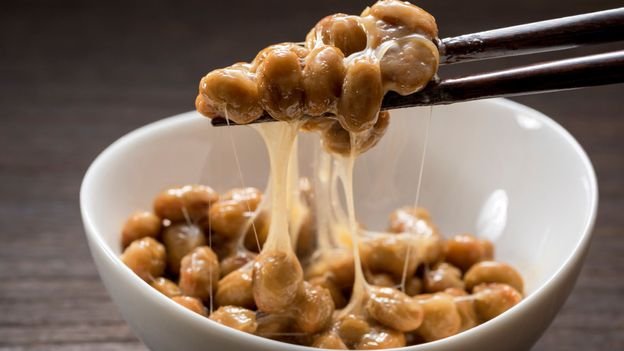
History and Background of Natto
Natto, a unique and acquired taste in Japanese cuisine, has a history dating back over a thousand years. Originating in the Tohoku region of Japan, natto is fermented soybeans known for their distinct aroma and sticky texture.
The dish gained popularity as a traditional breakfast food and is celebrated for its health benefits, including being a rich source of probiotics and nutrients.
Region of Origin
Natto finds its roots in the Tohoku region, but its popularity has spread throughout Japan and beyond. Today, it is commonly consumed across the country, with various regional preferences and styles of preparation.
Ingredients for Natto
- 2 packs of natto (fermented soybeans)
- 2 tablespoons soy sauce
- 1 tablespoon mirin (sweet rice wine)
- 1 teaspoon Dijon mustard
- 1 green onion, finely chopped
- Optional toppings: pickled radish, shiso leaves, or raw egg
Recipe for Natto
Preparation
- Prepare Natto:
- Open the natto packs and stir the beans with chopsticks to achieve a sticky consistency.
- Prepare Sauce:
- In a small bowl, mix soy sauce, mirin, and Dijon mustard to create a flavorful sauce.
Cooking
- Combine Natto and Sauce:
- Pour the sauce over the stirred natto. Mix thoroughly to coat the beans evenly.
- Optional Toppings:
- Enhance the flavor by adding finely chopped green onions and your choice of optional toppings such as pickled radish, shiso leaves, or a raw egg.
- Serve:
- Spoon the seasoned natto over steamed rice or eat it on its own.
Serving Information
- Servings: 2
- Preparation Time: 5 minutes
- Calories (per serving): Approximately 150 kcal
Enjoy natto as a nutritious and distinct part of Japanese cuisine, whether you appreciate its acquired taste or are seeking the health benefits of fermented soybeans.
Japanese Food – Oden

History and Background of Oden
Oden is a classic Japanese hot pot dish with a history dating back to the Edo period (1603–1868). Originating as a street food, vendors would carry portable carts with simmering pots during the colder months.
Over time, oden became a beloved winter comfort food enjoyed across Japan. Consisting of various ingredients simmered in a soy-based broth, oden reflects the country’s culinary diversity and regional preferences.
Region of Origin
Oden’s roots are deeply embedded in Tokyo, where it first gained popularity. However, its popularity has spread throughout Japan, with each region incorporating its own unique twist to the dish.
Oden is traditionally enjoyed during the colder months and is a common sight at convenience stores and izakayas across the country.
Ingredients for Oden
- 1 daikon radish, peeled and sliced
- 4 hard-boiled eggs, peeled
- 4 Japanese fish cakes (oden-maki)
- 4 konjac (konnyaku) cakes, sliced
- 4 deep-fried tofu pouches (aburaage), stuffed with mochi or fish cake
- 2 pieces kombu (dried kelp)
- 1 liter dashi (Japanese soup stock)
- 1/2 cup soy sauce
- 3 tablespoons mirin (sweet rice wine)
- 1 tablespoon sake (Japanese rice wine)
- Mustard and grated daikon for serving
Recipe for Oden
Preparation
- Prepare Ingredients:
- Peel and slice the daikon radish.
- Peel the hard-boiled eggs.
- Cut the Japanese fish cakes, konjac cakes, and deep-fried tofu pouches into bite-sized pieces.
- Prepare Dashi Broth:
- In a large pot, combine dashi, soy sauce, mirin, and sake. Bring to a gentle simmer.
Cooking
- Simmer Ingredients:
- Add the daikon radish, hard-boiled eggs, Japanese fish cakes, konjac cakes, deep-fried tofu pouches, and kombu to the simmering broth.
- Let the ingredients simmer for at least 30 minutes to allow flavors to meld.
- Serve:
- Ladle the oden and broth into bowls, ensuring each bowl has a variety of ingredients.
- Serve with mustard and grated daikon on the side.
Serving Information
- Servings: 4
- Cooking Time: 45 minutes
- Calories (per serving): Approximately 200 kcal
Enjoy the warmth and heartiness of oden, a delightful winter dish that brings together diverse ingredients in a comforting and flavorful broth.
Japanese Food – Kashi Pan

History and Background of Kashi Pan
Kashi Pan, or Japanese sweet bread, has a history deeply intertwined with the evolution of Western-style baking in Japan. Introduced during the Meiji era (1868–1912), kashi pan reflects the blending of Japanese and European culinary traditions.
These sweet bread buns, often filled or topped with various fillings and ingredients, have become a popular snack or breakfast option in Japan. Kashi pan showcases the adaptability of traditional Japanese flavors and ingredients to create a delightful fusion of culinary influences.
Region of Origin
Kashi pan is a widespread and beloved treat found throughout Japan. While its origins are not tied to a specific region, kashi pan has become an integral part of Japanese bakeries and breakfast culture across the country.
Ingredients for Kashi Pan
For the Bread Dough:
- 3 cups bread flour
- 1/4 cup granulated sugar
- 1 teaspoon salt
- 2 1/4 teaspoons active dry yeast
- 1 cup warm milk
- 1/4 cup unsalted butter, softened
- 1 large egg
For Filling or Topping (Customizable):
- Anko (sweet red bean paste)
- Custard cream
- Chocolate chips
- Matcha (green tea) cream
- Sesame seeds
- Sugar for dusting
Recipe for Kashi Pan
Bread Dough Preparation
- Activate Yeast:
- In a bowl, combine warm milk and sugar. Sprinkle yeast over the mixture, let it sit for 5-10 minutes until foamy.
- Mix Dough:
- In a large bowl, combine bread flour and salt.
- Add the activated yeast mixture, softened butter, and egg.
- Knead the dough until smooth and elastic.
- First Rise:
- Place the dough in a greased bowl, cover with a cloth, and let it rise in a warm place for about 1 hour or until doubled in size.
Filling or Topping Preparation
- Prepare Filling or Topping:
- Depending on your preference, prepare sweet red bean paste, custard cream, matcha cream, or any other desired filling.
Shaping and Second Rise
- Divide and Shape:
- Punch down the risen dough and divide it into equal portions.
- Shape each portion into rounds or ovals.
- Add Filling or Topping:
- If using filling, place a small amount in the center of each dough portion.
- If using toppings, press them gently onto the surface of the dough.
- Second Rise:
- Place the shaped kashi pan on a baking sheet, cover, and let them rise again for about 30 minutes.
Baking
- Preheat and Bake:
- Preheat the oven to 350°F (180°C).
- Bake the kashi pan for 15-20 minutes or until golden brown.
- Cool and Dust:
- Allow the kashi pan to cool on a wire rack.
- Dust with sugar or any desired topping.
Serving Information
- Servings: 12
- Cooking Time: 2 hours (including rising time)
- Calories (per serving): Approximately 200 kcal
Enjoy the delightful and customizable kashi pan, a sweet Japanese bread that combines the best of Japanese and Western baking traditions.
Japanese Food – Tamagoyaki
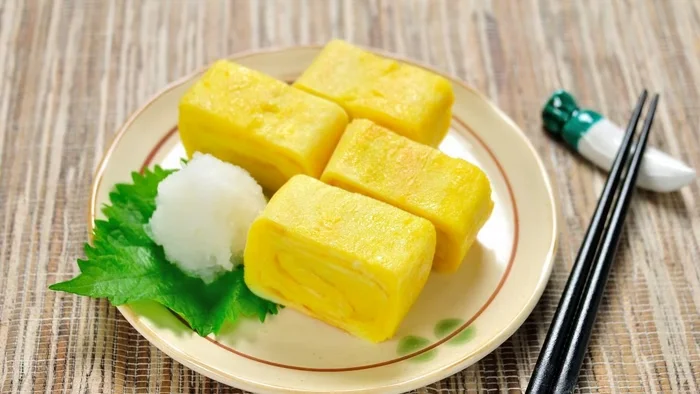
History and Background of Tamagoyaki
Tamagoyaki, a staple of Japanese cuisine, is a rolled omelet with a history dating back to the Edo period (1603–1868). Originally known as “tamago-yaki,” meaning grilled egg, this dish has evolved into a beloved breakfast item and bento box essential.
Tamagoyaki showcases the delicate art of Japanese cooking, requiring skillful layering and rolling to create its distinctive texture and taste.
Region of Origin
Tamagoyaki is a dish enjoyed throughout Japan, but it has strong ties to the Kanto region, particularly Tokyo. Variations of tamagoyaki exist across the country, each region contributing its unique flair to the beloved rolled omelet.
Ingredients for Tamagoyaki
- 4 large eggs
- 2 tablespoons sugar
- 1 tablespoon soy sauce
- 1/2 teaspoon mirin (sweet rice wine)
- 1/4 teaspoon salt
- 1 tablespoon neutral oil (vegetable or canola)
- Optional: chopped scallions, cooked shrimp, or nori (seaweed) for added flavor and texture
Recipe for Tamagoyaki
Preparation
- Prepare Tamagoyaki Pan:
- Use a rectangular tamagoyaki pan or a non-stick skillet. Brush the pan with a thin layer of oil.
- Whisk Eggs:
- In a bowl, whisk the eggs thoroughly.
- Add sugar, soy sauce, mirin, and salt to the eggs. Mix well until the sugar is dissolved.
Cooking
- Cooking the Layers:
- Heat the tamagoyaki pan over medium heat.
- Pour a thin layer of the egg mixture into the pan, allowing it to set but not fully cook.
- Rolling the Layers:
- Once the first layer is set, roll it towards the far end of the pan.
- Push the rolled egg back to the original side of the pan, creating a new space for the next layer.
- Pour more egg mixture to cover the pan and the rolled egg. Let it set, then roll it over the existing layers.
- Repeat and Shape:
- Repeat the process until all the egg mixture is used.
- Shape the rolled omelet by pressing it gently with the spatula.
- Optional Additions:
- For added flavor and texture, sprinkle chopped scallions, cooked shrimp, or nori on one edge of the egg before rolling.
Serving Information
- Servings: 4
- Cooking Time: 15 minutes
- Calories (per serving): Approximately 120 kcal
Enjoy this delightful and visually appealing Tamagoyaki as part of a Japanese breakfast or as a tasty addition to your bento box.
Japanese Food – Soba

History and Background of Soba
Soba, a traditional Japanese noodle made from buckwheat flour, has a rich history dating back to the Edo period (1603–1868). Originating in the mountainous regions of Japan, soba noodles gained popularity for their versatility and nutritional benefits.
Soba can be enjoyed in various forms, from chilled noodles served with dipping sauce (zaru soba) to hot noodle soups. This culinary tradition reflects the simplicity and elegance of Japanese cuisine.
Region of Origin
Soba is closely associated with the mountainous regions of Japan, particularly Nagano and Niigata. The cooler climate in these areas is conducive to growing high-quality buckwheat, contributing to the prominence of soba noodles in their culinary traditions.
Today, soba is enjoyed throughout Japan and is often associated with special occasions and celebrations.
Ingredients for Soba
- 8 ounces (about 225g) dried soba noodles
- 4 cups dashi (Japanese soup stock)
- 1/2 cup soy sauce
- 3 tablespoons mirin (sweet rice wine)
- 1 tablespoon sake (Japanese rice wine)
- Optional toppings: sliced green onions, grated daikon radish, nori (seaweed), and tempura
Recipe for Soba
Preparation
- Cook Soba Noodles:
- Boil soba noodles according to package instructions.
- Rinse under cold water to remove excess starch and cool the noodles.
- Prepare Dashi Broth:
- In a pot, combine dashi, soy sauce, mirin, and sake. Bring to a gentle simmer.
Cooking
- Serve Hot Soba:
- Place a portion of cooked soba noodles into individual serving bowls.
- Ladle the hot dashi broth over the soba noodles.
- Optional Toppings:
- Garnish the soba with sliced green onions, grated daikon radish, and nori strips.
- Serve with Tempura (Optional):
- Accompany the soba with tempura on the side for a complete meal.
Serving Information
- Servings: 4
- Cooking Time: 15 minutes
- Calories (per serving): Approximately 300 kcal
Enjoy the simplicity and authentic flavors of Japanese cuisine with this comforting bowl of hot soba noodles, perfect for any occasion.
Japanese Food – Tonkatsu
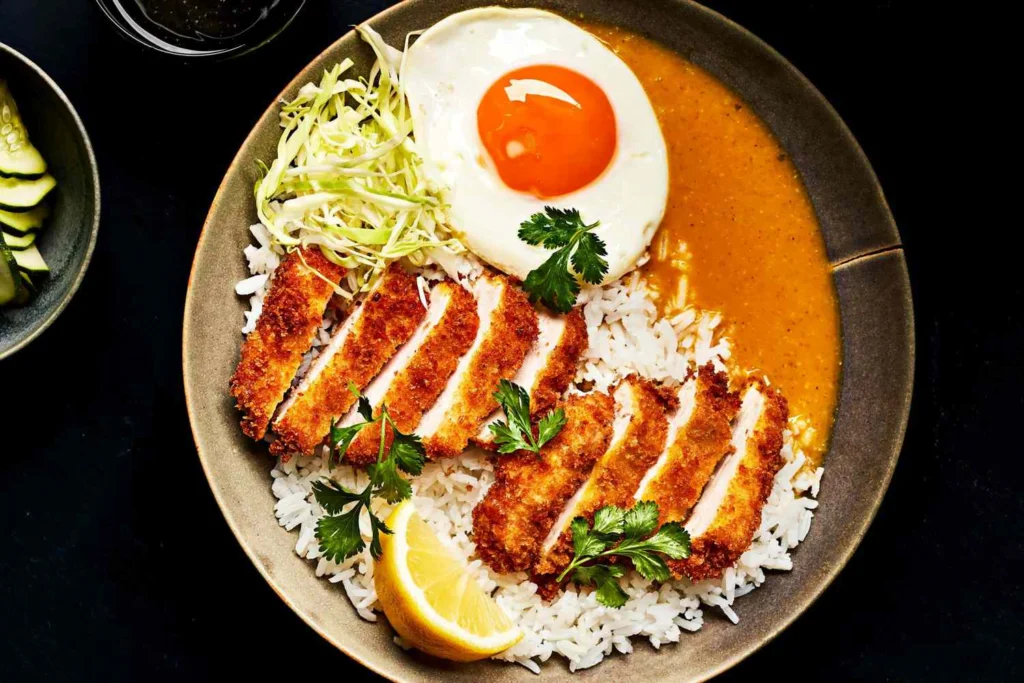
History and Background of Tonkatsu
Tonkatsu, a popular Japanese dish, has its roots in the late 19th century when Japan opened its doors to Western influences. This breaded and deep-fried pork cutlet is a delightful fusion of Japanese and European culinary styles.
Tonkatsu quickly gained popularity in Tokyo and has since become a beloved comfort food enjoyed across Japan. The dish exemplifies the art of deep-frying introduced during the Meiji era and has evolved into various regional styles and adaptations.
Region of Origin
Tonkatsu is most closely associated with Tokyo, where it gained prominence in the early 20th century. Today, you can find tonkatsu restaurants throughout Japan, each adding its unique touch to the dish. It’s a versatile dish served in homes, casual eateries, and high-end restaurants alike.
Ingredients for Tonkatsu
- 4 pork loin or pork tenderloin cutlets (about 1/2 inch thick)
- Salt and pepper for seasoning
- All-purpose flour for dredging
- 2 large eggs, beaten.
- 1 cup panko breadcrumbs
- Vegetable oil for deep frying
- Tonkatsu sauce for serving.
- Optional: shredded cabbage and sliced lemon for garnish
Recipe for Tonkatsu
Preparation
- Prepare Pork Cutlets:
- Season pork cutlets with salt and pepper.
- Dredge in Flour:
- Dredge each pork cutlet in all-purpose flour, shaking off excess.
Cooking
- Coat in Beaten Eggs:
- Dip the floured pork cutlets into beaten eggs, ensuring even coating.
- Bread with Panko:
- Coat the cutlets with panko breadcrumbs, pressing gently to adhere.
- Deep Fry:
- Heat vegetable oil in a deep fryer or a large, deep skillet to 350°F (175°C).
- Carefully place the breaded pork cutlets into the hot oil and fry until golden brown and cooked through, about 4-5 minutes per side.
- Drain and Rest:
- Remove tonkatsu from the oil and drain on paper towels. Let it rest for a few minutes.
- Serve:
- Slice tonkatsu into strips.
- Serve with shredded cabbage, sliced lemon, and tonkatsu sauce on the side.
Serving Information
- Servings: 4
- Cooking Time: 15 minutes
- Calories (per serving): Approximately 400 kcal
Enjoy the crispy and golden exterior with the tender interior of tonkatsu, a delicious and iconic Japanese dish that captures the essence of comfort food with every bite.
Japanese Food – Sukiyaki

History and Background of Sukiyaki
Sukiyaki, a classic Japanese hot pot dish, has a history rooted in the late 19th century. Originally known as “gyu-nabe” (beef pot), sukiyaki gained popularity during the Meiji era when Japan opened up to Western influences. The dish underwent transformations over time, evolving into the sweet and savory hot pot enjoyed today.
Sukiyaki reflects the communal and convivial aspect of Japanese dining, where thinly sliced beef, vegetables, and other ingredients are cooked together in a shared pot at the table.
Region of Origin
Sukiyaki is associated with the Kanto region, particularly Tokyo, where it gained prominence. While it is enjoyed throughout Japan, there are regional variations in the ingredients and the way the dish is prepared. Sukiyaki is often enjoyed in the colder months and during special occasions.
Ingredients for Sukiyaki
- 1 pound (about 450g) thinly sliced beef (usually ribeye or sirloin)
- 1/2 cup soy sauce
- 1/4 cup mirin (sweet rice wine)
- 1/4 cup sake (Japanese rice wine)
- 3 tablespoons sugar
- 1 tablespoon vegetable oil
- 1 onion, thinly sliced
- 1 leek, sliced diagonally
- 1/2 napa cabbage, cut into bite-sized pieces
- 8 shiitake mushrooms, stems removed
- 1 bunch enoki mushrooms, bottom trimmed
- 1 package firm tofu, cut into cubes
- 4 green onions, cut into 2-inch lengths
- 2 cups shirataki noodles, rinsed and drained
- 4 eggs (for dipping)
Recipe for Sukiyaki
Preparation
- Prepare Ingredients:
- Slice the beef thinly.
- Cut vegetables and tofu into bite-sized pieces.
- Remove the stems from shiitake mushrooms.
Cooking
- Prepare Sukiyaki Sauce:
- In a bowl, mix soy sauce, mirin, sake, and sugar to create the sukiyaki sauce.
- Heat the Pan:
- Heat a sukiyaki pan or a large skillet over medium heat.
- Add vegetable oil.
- Cook Beef:
- Add the sliced beef to the pan and cook until browned.
- Add Vegetables and Tofu:
- Pour the sukiyaki sauce over the beef.
- Add onions, leeks, napa cabbage, shiitake mushrooms, enoki mushrooms, tofu, green onions, and shirataki noodles to the pan.
- Simmer:
- Allow the ingredients to simmer in the sauce until vegetables are tender and flavors meld.
- Serve:
- Crack eggs into individual bowls for dipping.
- Serve sukiyaki hot, allowing each person to dip the cooked ingredients into the raw egg before eating.
Serving Information
- Servings: 4
- Cooking Time: 30 minutes
- Calories (per serving): Approximately 400 kcal
Enjoy the communal experience of sukiyaki, a delicious and comforting hot pot that brings together the flavors of thinly sliced beef, vegetables, and a savory-sweet sauce.
Japanese Food – Mentaiko

History and Background of Mentaiko
Mentaiko, a popular Japanese delicacy, has a fascinating history originating in Korea during the early 20th century. Mentaiko consists of spicy marinated pollock or cod roe, a creation credited to a Korean immigrant in the city of Fukuoka, Japan.
The name “mentaiko” is derived from the Korean term “myeongran jeot,” and the dish has evolved into a beloved staple in Japanese cuisine. Typically enjoyed as a condiment or filling, mentaiko’s spicy and briny flavors have made it a versatile and sought-after ingredient.
Region of Origin
Fukuoka, located on the island of Kyushu, is recognized as the birthplace and primary producer of mentaiko. However, its popularity has spread throughout Japan, and it is now a widely enjoyed ingredient in various regional cuisines.
Ingredients for Mentaiko Pasta
- 12 ounces (about 340g) spaghetti or pasta of your choice
- 2 tablespoons unsalted butter
- 2 cloves garlic, minced
- 1/2 cup heavy cream
- 1/2 cup grated Parmesan cheese
- 1 tablespoon soy sauce
- 1 teaspoon sake (Japanese rice wine) – optional
- 1/2 cup mentaiko (spicy cod roe), sac removed and mashed
- Chopped chives or green onions for garnish
- Nori (seaweed) strips for garnish – optional
Recipe for Mentaiko Pasta
Preparation
- Cook Pasta:
- Cook the pasta in salted boiling water according to package instructions. Drain and set aside.
- Prepare Mentaiko:
- Remove the sac from the mentaiko and mash it is using a fork.
Cooking
- Make Mentaiko Sauce:
- In a pan, melt butter over medium heat.
- Add minced garlic and sauté until fragrant.
- Add heavy cream, grated Parmesan cheese, soy sauce, and sake (if using).
- Stir until the cheese is melted and the sauce is well combined.
- Add Mentaiko:
- Add mashed mentaiko to the sauce. Mix well until the mentaiko is evenly distributed.
- Combine Pasta and Sauce:
- Add the cooked pasta to the mentaiko sauce. Toss until the pasta is well coated.
Serving Information
- Servings: 4
- Cooking Time: 20 minutes
- Calories (per serving): Approximately 500 kcal
- Garnish and Serve:
- Garnish with chopped chives or green onions.
- Optionally, sprinkle nori strips on top.
- Serve hot.
Enjoy the creamy and flavorful Mentaiko Pasta, where the spiciness of the cod roe complements the richness of the creamy sauce for a delightful Japanese-Italian fusion dish.
Japanese Food – Nikujaga

History and Background of Nikujaga
Nikujaga, a quintessential Japanese comfort dish, traces its origins back to the Meiji era (1868–1912). Meaning “meat and potatoes” in Japanese, nikujaga emerged during a time of Western influence on Japanese cuisine.
The dish reflects a fusion of traditional Japanese ingredients, such as soy sauce and sake, with the introduction of potatoes and meat. Nikujaga has since become a household staple, cherished for its hearty and savory flavors, and it exemplifies the evolving nature of Japanese culinary traditions.
Region of Origin
Nikujaga is a dish enjoyed throughout Japan, with variations in recipes and ingredients depending on regional preferences. It is commonly prepared in homes and served in restaurants across the country.
Ingredients for Nikujaga
- 1 pound (about 450g) thinly sliced beef
- 4 medium potatoes, peeled and cut into chunks
- 2 medium carrots, peeled and sliced
- 1 onion, thinly sliced
- 1 cup green beans, cut into bite-sized pieces
- 1/4 cup soy sauce
- 3 tablespoons sugar
- 3 tablespoons mirin (sweet rice wine)
- 2 tablespoons sake (Japanese rice wine)
- 2 cups dashi (Japanese soup stock)
- 2 tablespoons vegetable oil
- Salt to taste
- Chopped green onions for garnish
Recipe for Nikujaga
Preparation
- Prepare Ingredients:
- Peel and cut potatoes into chunks.
- Slice carrots, onions, and green beans.
- Thinly slice beef.
Cooking
- Saute Beef:
- In a large pot, heat vegetable oil over medium heat.
- Add sliced beef and cook until browned.
- Add Vegetables:
- Add onions to the pot and sauté until softened.
- Stir in potatoes, carrots, and green beans.
- Make Sauce:
- In a bowl, mix soy sauce, sugar, mirin, sake, and dashi to create the sauce.
- Simmer:
- Pour the sauce over the vegetables and beef in the pot.
- Bring to a boil, then reduce heat to simmer.
- Cover and cook until potatoes are tender, about 20-25 minutes.
- Adjust Seasoning:
- Taste and adjust the seasoning with salt if necessary.
- Serve:
- Garnish with chopped green onions.
- Serve hot over steamed rice.
Serving Information
- Servings: 4
- Cooking Time: 40 minutes
- Calories (per serving): Approximately 400 kcal
Enjoy the comforting flavors of Nikujaga, a classic Japanese stew that brings together the heartiness of meat and potatoes with the umami richness of soy sauce and dashi.
Japanese Food – Curry Rice
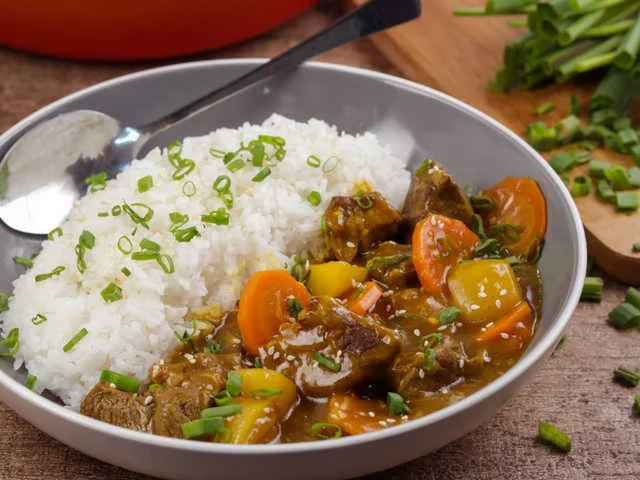
History and Background of Curry Rice
Curry Rice, known as “kare raisu” in Japanese, has a unique history with roots in the late 19th century. Introduced to Japan by the British during the Meiji era, curry quickly became a popular and beloved dish. The Japanese adapted curry to suit local tastes, creating a milder and sweeter version than its Indian or British counterparts.
Over time, Curry Rice has become a staple in Japanese households, schools, and restaurants, offering a comforting blend of aromatic curry sauce served over steamed rice.
Region of Origin
Curry Rice is a widely enjoyed dish throughout Japan and has become a symbol of comfort food. Each region may have its variations, with some places incorporating local ingredients or unique twists to the recipe.
Ingredients for Curry Rice
For the Curry Sauce:
- 2 tablespoons vegetable oil
- 1 onion, finely chopped
- 2 carrots, peeled and diced
- 2 potatoes, peeled and diced
- 1 pound (about 450g) meat of choice (beef, chicken, or pork), cut into bite-sized pieces
- 3 cups water
- 1 box (200g) curry roux blocks (Japanese curry roux)
- 1 tablespoon soy sauce
- 1 tablespoon Worcestershire sauce
- 1 tablespoon ketchup
- Salt and pepper to taste
For Serving:
- Steamed rice
Recipe for Curry Rice
Preparation
- Prepare Vegetables and Meat:
- Finely chop the onion.
- Dice the carrots and potatoes into bite-sized pieces.
- Cut the meat into cubes.
Cooking
- Sauté Vegetables and Meat:
- In a large pot, heat vegetable oil over medium heat.
- Add chopped onions and sauté until translucent.
- Add meat and cook until browned.
- Add carrots and potatoes, sauté for a few minutes.
- Make Curry Sauce:
- Pour water into the pot and bring to a boil.
- Lower the heat and add curry roux blocks. Stir until fully dissolved.
- Add soy sauce, Worcestershire sauce, ketchup, salt, and pepper. Simmer until the sauce thickens and vegetables are tender.
- Simmer:
- Let the curry simmer on low heat, stirring occasionally, for about 20-30 minutes until it reaches the desired consistency.
- Serve:
- Spoon curry over steamed rice in individual bowls.
Serving Information
- Servings: 4
- Cooking Time: 45 minutes
- Calories (per serving): Approximately 500 kcal
Enjoy the heartwarming flavors of Curry Rice, a beloved Japanese comfort dish that brings together a rich and flavorful curry sauce with tender meat and vegetables served over a bed of steamed rice.
Japanese Food – Unagi no Kabayaki
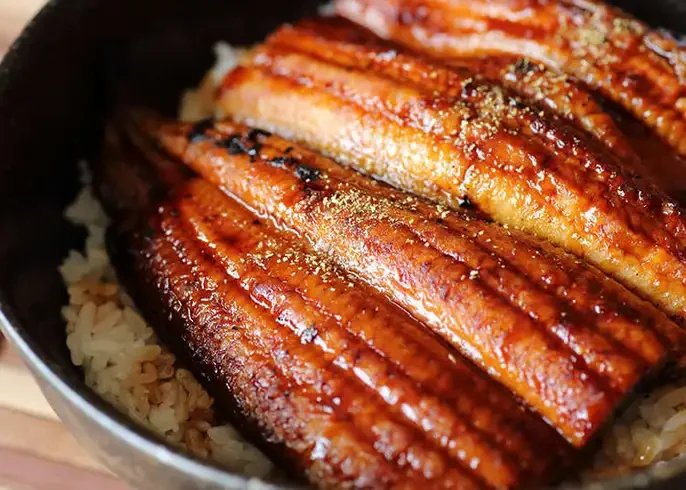
History and Background of Unagi no Kabayaki
Unagi no Kabayaki, or grilled eel with sweet soy-based sauce, has a long history in Japanese cuisine dating back centuries. Traditionally associated with the midsummer day of the ox in the lunar calendar, consuming unagi is believed to provide stamina and vitality to endure the hot summer months.
The preparation of unagi involves skewering freshwater eel, grilling it over charcoal, and basting it with a sweet soy-based sauce. Unagi no Kabayaki has evolved into a cherished culinary tradition, often enjoyed as a special treat in Japan.
Region of Origin
Unagi no Kabayaki is popular across Japan, but certain regions, such as Nagoya and Hamamatsu, are renowned for their unique styles of preparing and consuming grilled eel. These regional variations may include different methods of marination and grilling, resulting in distinct flavors.
Ingredients for Unagi no Kabayaki
- 2 unagi (freshwater eel) fillets
- 1 cup sweet soy-based kabayaki sauce
- 2 tablespoons mirin (sweet rice wine)
- 1 tablespoon sake (Japanese rice wine)
- 1 tablespoon sugar
- 2 cups steamed white rice
- Sansho (Japanese pepper) for garnish – optional
- Chopped green onions for garnish – optional
Recipe for Unagi no Kabayaki
Preparation
- Prepare Kabayaki Sauce:
- In a saucepan, combine sweet soy-based kabayaki sauce, mirin, sake, and sugar.
- Heat over low-medium heat, stirring until the sugar dissolves. Let it cool.
Cooking
- Prepare Unagi:
- Score the skin of the unagi fillets with a sharp knife to ensure even cooking.
- Grill the eel fillets over charcoal or a broiler until both sides are slightly charred.
- Apply Sauce:
- Brush a layer of the prepared kabayaki sauce over the eel fillets.
- Continue grilling, basting with the sauce, until the eel is fully cooked and glazed.
- Serve:
- Place a bed of steamed white rice on a plate.
- Lay the grilled unagi fillets over the rice.
- Garnish with sansho and chopped green onions if desired.
Serving Information
- Servings: 2
- Cooking Time: 20 minutes
- Calories (per serving): Approximately 400 kcal
Enjoy the exquisite flavors of Unagi no Kabayaki, a classic Japanese delicacy that combines the rich, smoky taste of grilled eel with the sweetness of the kabayaki sauce.
Japanese Food – Shabu Shabu Hot Pot
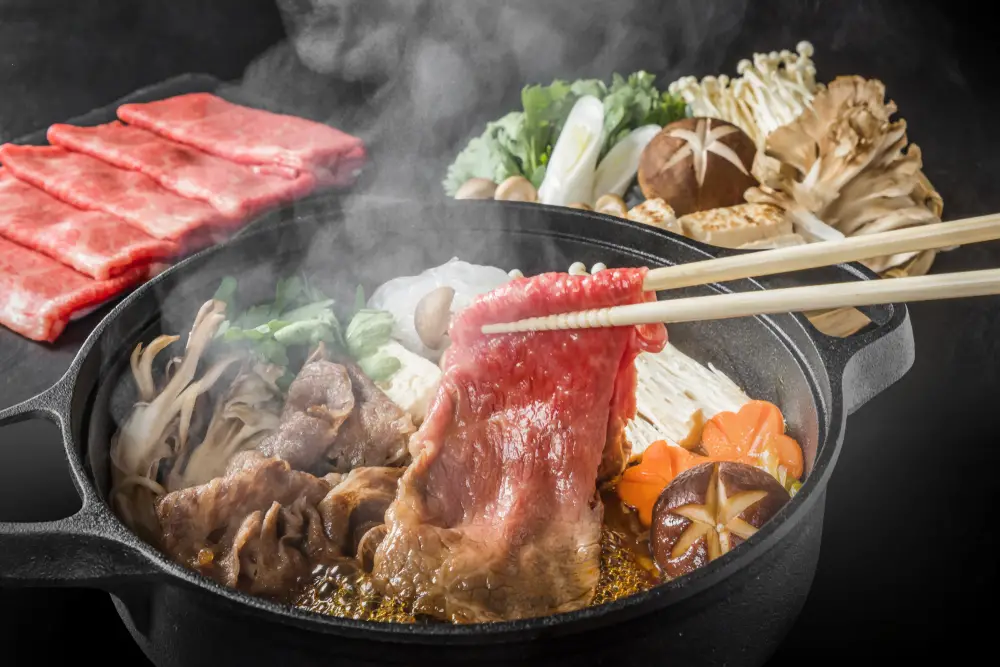
History and Background of Shabu Shabu Hot Pot
Shabu Shabu, a popular Japanese hot pot dish, has its origins in the 20th century. The dish was inspired by the Chinese hot pot and sukiyaki, evolving into a unique and interactive dining experience.
The name “shabu shabu” is an onomatopoeic term derived from the swishing sound made when thin slices of meat are quickly swirled in the boiling broth. Shabu Shabu emphasizes fresh, high-quality ingredients and a communal dining atmosphere, making it a favorite for gatherings and special occasions.
Region of Origin
Shabu Shabu is enjoyed throughout Japan, but it gained popularity in Osaka during the 1950s before spreading to other regions. Today, it is a cherished dish served in specialized shabu shabu restaurants and homes across the country.
Ingredients for Shabu Shabu Hot Pot
Broth:
- 6 cups dashi (Japanese soup stock)
- 1/4 cup soy sauce
- 3 tablespoons mirin (sweet rice wine)
- 1 tablespoon sake (Japanese rice wine)
- 1 tablespoon sugar
For the Hot Pot:
- Thinly sliced beef (sirloin or ribeye)
- Assorted vegetables (napa cabbage, shiitake mushrooms, enoki mushrooms, carrots, and green onions)
- Tofu, sliced
- Shungiku (chrysanthemum greens) or spinach
- Udon or cellophane noodles
- Dipping sauces (ponzu sauce, goma dare – sesame sauce)
Recipe for Shabu Shabu Hot Pot
Preparation
- Prepare Broth:
- In a pot, combine dashi, soy sauce, mirin, sake, and sugar.
- Bring the broth to a simmer over medium heat.
- Prepare Ingredients:
- Arrange thinly sliced beef, assorted vegetables, tofu, shungiku or spinach, and noodles on serving plates.
Cooking
- Cooking in the Hot Pot:
- Place the hot pot in the center of the dining table, with the simmering broth.
- Each person swishes slices of beef in the hot broth until just cooked.
- Add vegetables, tofu, and noodles to the hot pot, allowing them to cook briefly.
- Dipping Sauces:
- Serve dipping sauces like ponzu sauce and goma dare for added flavor.
Serving Information
- Servings: 4
- Cooking Time: 20 minutes
- Calories (per serving): Approximately 300 kcal
- Enjoying the Hot Pot:
- Once cooked, dip the ingredients in the desired sauce and enjoy the hot pot with rice or udon on the side.
Shabu Shabu Hot Pot offers a delightful and interactive dining experience, allowing each person to customize their meal while savoring the freshness of the ingredients in a communal setting.
Japanese Food – Onigiri

History and Background of Onigiri
Onigiri, also known as rice balls or omusubi, has been a staple in Japanese cuisine for centuries. With origins dating back to the Nara period (8th century), onigiri evolved from a simple rice ball into a versatile and beloved convenience food.
Traditionally, onigiri was made with salted or pickled ingredients to preserve rice during long journeys. Today, onigiri is a popular snack enjoyed in various forms, filled with ingredients like grilled fish, pickled plum, or seasoned seaweed, and often wrapped in nori (seaweed).
Onigiri reflects the practicality and creativity deeply embedded in Japanese culinary culture.
Region of Origin
Onigiri is a ubiquitous dish found throughout Japan and is enjoyed in various forms across the country. It is commonly sold in convenience stores, made at home, and is an integral part of Japanese bento (packed lunch) culture.
Ingredients for Onigiri
Rice:
- 2 cups sushi rice
- 2 1/4 cups water
- 1/4 cup rice vinegar
- 2 tablespoons sugar
- 1 teaspoon salt
Filling and Wrapping:
- Nori (seaweed) sheets, cut into strips
- Various fillings (grilled salmon, pickled plum, seasoned seaweed, tuna mayo, etc.)
Recipe for Onigiri
Preparation
- Prepare Rice:
- Rinse sushi rice under cold water until the water runs clear.
- Combine rice and water in a rice cooker. Cook the rice.
- In a small bowl, mix rice vinegar, sugar, and salt. Fold this mixture into the cooked rice.
- Prepare Filling:
- Prepare your chosen fillings, such as grilling salmon, preparing pickled plum, or seasoning seaweed.
Shaping Onigiri
- Moisten Hands:
- Moisten your hands with water and sprinkle a little salt on them to prevent sticking.
- Forming Rice Balls:
- Take a handful of seasoned rice and shape it into a triangle or oval.
- If adding a filling, make an indentation in the center and place the filling.
- Wrapping in Nori:
- If using nori, wrap the onigiri with a strip, securing it in the middle.
Serving Information
- Servings: 6-8 onigiri
- Preparation Time: 30 minutes
- Calories (per onigiri): Approximately 150 kcal
- Enjoying Onigiri:
- Onigiri can be served immediately or wrapped in plastic wrap for later consumption.
- Enjoy it as a snack, part of a bento, or a quick and convenient meal.
Onigiri is a versatile and customizable dish that reflects the essence of Japanese culinary traditions. Whether enjoyed at home, on the go, or as a part of a bento box, onigiri remains a symbol of comfort and simplicity in Japanese cuisine.
Japanese Food – Gyoza (Dumplings)
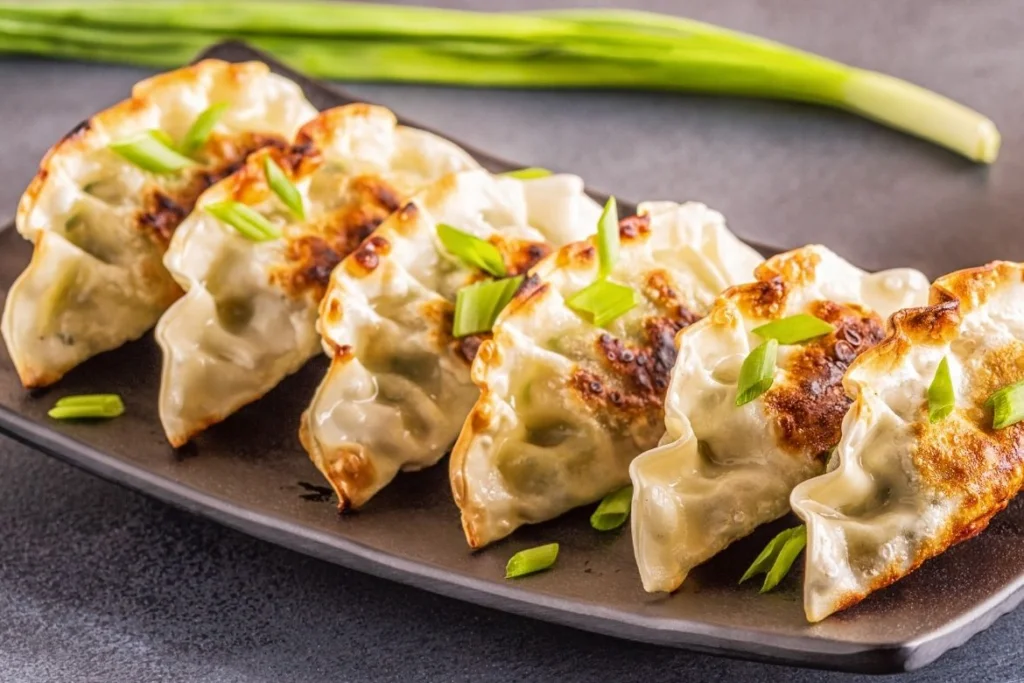
History and Background of Gyoza
Gyoza, originally derived from Chinese dumplings, has become a beloved and distinctive dish in Japanese cuisine. Introduced to Japan by Chinese immigrants, gyoza underwent adaptations to suit Japanese tastes and preferences.
These crescent-shaped dumplings typically consist of a thin dough filled with a mixture of ground meat, vegetables, and seasonings. Gyoza is commonly pan-fried until crispy on the bottom and served with a dipping sauce.
Over time, gyoza has evolved into a popular appetizer, snack, or side dish enjoyed in homes and restaurants across Japan.
Region of Origin
Gyoza is enjoyed throughout Japan, and various regions may have their unique styles of preparing and serving these dumplings. It is a versatile dish that has become an integral part of Japanese culinary culture.
Ingredients for Gyoza
Filling:
- 1/2 pound (about 225g) ground pork
- 1 cup Napa cabbage, finely chopped
- 2 green onions, finely chopped
- 2 cloves garlic, minced
- 1 teaspoon ginger, grated
- 1 tablespoon soy sauce
- 1 tablespoon sake (Japanese rice wine)
- 1 teaspoon sesame oil
- Salt and pepper to taste
Wrapper:
- Gyoza or dumpling wrappers (store-bought or homemade)
Cooking:
- Vegetable oil
Dipping Sauce:
- 2 tablespoons soy sauce
- 1 tablespoon rice vinegar
- 1/2 teaspoon sesame oil
- Red pepper flakes (optional)
Recipe for Gyoza
Preparation
- Prepare Filling:
- In a bowl, combine ground pork, chopped Napa cabbage, green onions, garlic, ginger, soy sauce, sake, sesame oil, salt, and pepper. Mix well.
- Assemble Gyoza:
- Place a small amount of filling in the center of a gyoza wrapper.
- Moisten the edges with water and fold the wrapper in half, creating a crescent shape. Pleat the edges to seal.
Cooking Gyoza
- Pan-Fry Gyoza:
- Heat vegetable oil in a pan over medium-high heat.
- Place gyoza in the pan, flat side down. Cook until the bottom is golden brown.
- Steam and Crisp:
- Add water to the pan, cover, and steam the gyoza for a few minutes.
- Uncover and let them crisp up on the bottom.
Dipping Sauce
- Prepare Dipping Sauce:
- In a small bowl, mix soy sauce, rice vinegar, sesame oil, and red pepper flakes (optional).
Serving Information
- Servings: Approximately 4-6 (about 24 gyoza)
- Cooking Time: 30 minutes
- Calories (per gyoza): Approximately 50 kcal
- Serve and Enjoy:
- Serve the gyoza hot with the dipping sauce on the side.
- Garnish with additional chopped green onions or sesame seeds if desired.
Gyoza is a delightful and flavorful dish that combines the savory goodness of the filling with the crispy texture of the wrapper. Whether enjoyed as an appetizer or a side dish, gyoza offers a satisfying culinary experience.
Japanese Food – Kaiseki Ryori
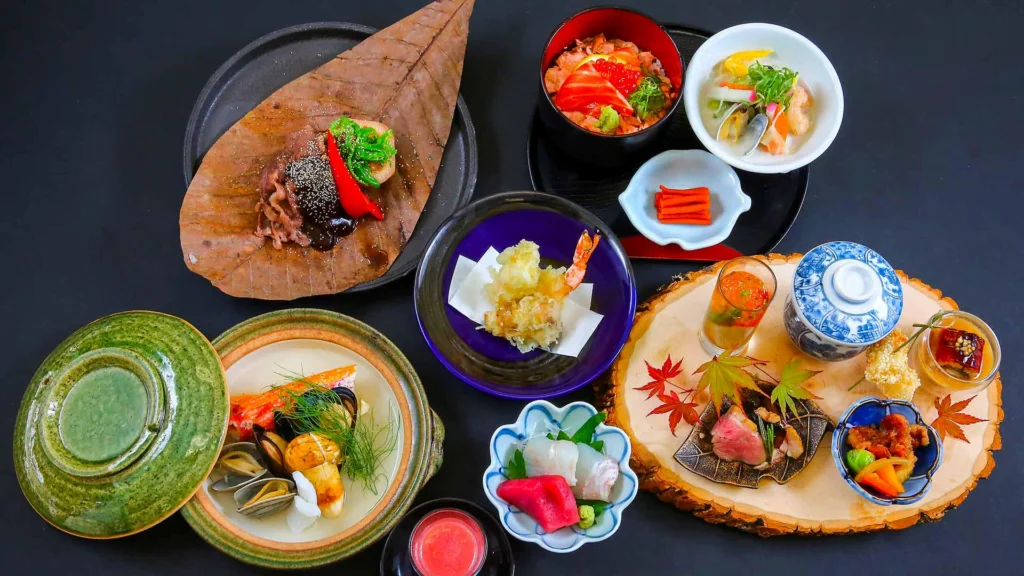
History and Background of Kaiseki Ryori
Kaiseki Ryori, often referred to as the pinnacle of Japanese haute cuisine, has a rich history dating back to the Japanese tea ceremony (cha-kaiseki) in the 16th century. Over time, it evolved into a multi-course dining experience that beautifully showcases seasonal and regional ingredients.
Kaiseki emphasizes balance, harmony, and the artful presentation of dishes, reflecting the traditional Japanese aesthetic. Originally associated with the tea ceremony, kaiseki has transcended its roots and is now enjoyed as an elaborate and sophisticated dining experience in ryotei (traditional Japanese restaurants) across Japan.
Region of Origin
Kaiseki Ryori is a culinary tradition that has its roots in Kyoto, the historical and cultural heart of Japan. While it originated as part of the tea ceremony, kaiseki has become a distinctive and revered form of dining that is practiced and appreciated throughout the country.
Ingredients for Kaiseki Ryori
Appetizer (Sakizuke):
- Seasonal sashimi (raw fish)
- Steamed or marinated vegetables
Soup (Suimono):
- Clear broth with seasonal ingredients
Small Side Dish (Hassun):
- Assortment of small dishes reflecting the season
Grilled Dish (Yakimono):
- Grilled fish or meat with a seasonal glaze
Simmered Dish (Nimono):
- Vegetables and proteins simmered in a delicate broth
Vinegared Dish (Sunomono):
- Lightly vinegared seasonal ingredients
Rice Course (Gohan):
- Steamed rice served with pickles and miso soup
Dessert (Mizumono):
- Seasonal fruits or sweets
Recipe for Kaiseki Ryori
Preparation
- Plan According to Seasons:
- Identify and source seasonal and regional ingredients.
Cooking Steps
- Sakizuke – Appetizer:
- Arrange seasonal sashimi and steamed or marinated vegetables on individual plates.
- Suimono – Soup:
- Prepare a clear broth with seasonal ingredients, served in small bowls.
- Hassun – Small Side Dish:
- Present an assortment of small dishes that reflect the season and harmonize in flavor.
- Yakimono – Grilled Dish:
- Grill fish or meat with a seasonal glaze, ensuring a perfect balance of textures and flavors.
- Nimono – Simmered Dish:
- Simmer vegetables and proteins in a delicate broth until tender.
- Sunomono – Vinegared Dish:
- Prepare lightly vinegared seasonal ingredients, served as a refreshing palate cleanser.
- Gohan – Rice Course:
- Serve steamed rice with pickles and miso soup.
- Mizumono – Dessert:
- Conclude the meal with seasonal fruits or traditional Japanese sweets.
Serving Information
- Servings: Typically designed for one person
- Preparation Time: Varies based on complexity
- Calories: The caloric content can vary widely depending on ingredients and portion sizes.
- Present with Elegance:
- Serve each course with attention to visual presentation, emphasizing the aesthetics of the season.
Kaiseki Ryori is an intricate and elegant dining experience that embodies the essence of Japanese culinary art. While it requires meticulous preparation and attention to detail, it provides a harmonious and memorable journey through the flavors and aesthetics of the season.
Japanese Food – Edamame

History and Background of Edamame
Edamame, young and tender soybeans, have been a part of Japanese cuisine for centuries. Originating in East Asia, edamame became popular in Japan during the Edo period (1603–1868).
Traditionally served as a snack with sea salt, edamame has grown in popularity worldwide due to its nutritional value and delicious taste. These green soybeans are not only a tasty appetizer but also a versatile ingredient used in various Japanese dishes, symbolizing health, freshness, and simplicity.
Region of Origin
Edamame is deeply rooted in Japanese culinary culture and is enjoyed across the country. It is commonly served in izakayas (Japanese pubs), restaurants, and households as a delightful and nutritious snack.
Ingredients for Edamame
- Fresh edamame pods
- Sea salt (for seasoning)
Recipe for Edamame
Preparation
- Select Fresh Edamame:
- Choose young and bright green edamame pods.
- Wash Edamame:
- Rinse the edamame pods under cold water to remove any dirt or debris.
Cooking
- Boil Edamame:
- In a large pot, bring water to a boil.
- Add a generous amount of salt to the boiling water.
- Add the edamame pods and cook for 3-5 minutes or until they are tender.
- Drain and Cool:
- Drain the boiled edamame and transfer them to a bowl of ice water to stop the cooking process.
Serving
- Season with Sea Salt:
- Place the edamame pods on a serving plate.
- Sprinkle sea salt over the pods, adjusting to taste.
Serving Information
- Servings: 4
- Cooking Time: 10 minutes
- Calories (per serving): Approximately 100 kcal
- Enjoying Edamame:
- To eat, hold the pod by one end and gently squeeze the beans into your mouth, discarding the pod.
- Edamame can be enjoyed as a snack, appetizer, or a healthy addition to salads and stir-fries.
Edamame offers a simple yet delightful culinary experience, showcasing the natural sweetness of young soybeans. Whether enjoyed as a snack or incorporated into various dishes, edamame brings a burst of freshness and nutrition to the Japanese dining table.
Japanese Street Food – Yakisoba

History and Background of Yakisoba
Yakisoba, a popular Japanese stir-fried noodle dish, has its roots in Chinese cuisine but has been embraced and transformed into a uniquely Japanese comfort food. Introduced to Japan in the early 20th century, yakisoba became a favorite street food and festival dish.
The dish typically features stir-fried noodles, vegetables, and protein, all coated in a savory and slightly sweet yakisoba sauce. Yakisoba’s widespread popularity and versatility have made it a staple in Japanese homes, food stalls, and casual eateries.
Region of Origin
Yakisoba is enjoyed throughout Japan and has become a beloved street food item at festivals and events across the country. Its adaptability has led to regional variations, showcasing diverse ingredients and flavors.
Ingredients for Yakisoba
Noodles:
- 400g yakisoba noodles (fresh or dried)
- Water for boiling
Stir-Fry:
- 2 tablespoons vegetable oil
- 1 onion, thinly sliced
- 1 carrot, julienned
- 1 small cabbage, thinly sliced
- 2 cups bean sprouts
- 200g thinly sliced pork, chicken, or tofu for a vegetarian option
Yakisoba Sauce:
- 3 tablespoons Worcestershire sauce
- 2 tablespoons soy sauce
- 1 tablespoon oyster sauce
- 1 tablespoon ketchup
- 1 tablespoon mirin (sweet rice wine)
- 1 tablespoon sugar
Optional Toppings:
- Aonori (dried seaweed flakes)
- Beni shoga (pickled red ginger)
- Katsuobushi (bonito flakes)
Recipe for Yakisoba
Preparation
- Boil Yakisoba Noodles:
- Cook the yakisoba noodles according to package instructions.
- Drain and rinse under cold water to stop the cooking process. Set aside.
Cooking the Stir-Fry
- Prepare Yakisoba Sauce:
- In a small bowl, mix Worcestershire sauce, soy sauce, oyster sauce, ketchup, mirin, and sugar to create the yakisoba sauce. Set aside.
- Stir-Fry Vegetables and Protein:
- In a large pan or wok, heat vegetable oil over medium-high heat.
- Add sliced onion, julienned carrot, and thinly sliced pork (or chicken/tofu). Stir-fry until the meat is cooked and vegetables are tender.
- Add Cabbage and Bean Sprouts:
- Add thinly sliced cabbage and bean sprouts to the pan. Continue to stir-fry until the cabbage is wilted.
- Incorporate Noodles and Sauce:
- Add the cooked yakisoba noodles to the pan.
- Pour the prepared yakisoba sauce over the noodles and vegetables.
- Toss everything together until well combined and heated through.
Serving Information
- Servings: 4
- Cooking Time: 20 minutes
- Calories (per serving): Approximately 400 kcal
- Serve Yakisoba:
- Divide the yakisoba among serving plates.
- Garnish with optional toppings such as aonori, beni shoga, and katsuobushi.
Yakisoba is a quick and flavorful dish that captures the essence of Japanese street food. Whether enjoyed at a festival, made at home, or served in a restaurant, yakisoba offers a satisfying blend of textures and savory-sweet flavors.
Japanese Food – Chawanmushi

History and Background of Chawanmushi
Chawanmushi, a traditional Japanese savory egg custard, has a history dating back to the Edo period (1603–1868). Originating as a part of the tea ceremony, chawanmushi evolved into a versatile dish enjoyed in various settings.
The name “chawanmushi” translates to “steamed in a teacup” as it was traditionally served in a teacup. This delicate dish typically consists of a flavorful broth, steamed egg custard, and a variety of ingredients such as chicken, shrimp, vegetables, and ginkgo nuts.
Chawanmushi represents the meticulous craftsmanship and attention to detail in Japanese culinary traditions.
Region of Origin
Chawanmushi is a dish enjoyed across Japan, and its preparation may vary regionally. While it has historical ties to the tea ceremony in Kyoto, chawanmushi is now a popular dish served in restaurants and households nationwide.
Ingredients for Chawanmushi
Broth:
- 2 cups dashi (Japanese soup stock)
- 2 tablespoons soy sauce
- 1 tablespoon mirin (sweet rice wine)
- 1/2 teaspoon salt
Custard:
- 4 large eggs
- 2 cups dashi
- 1/2 teaspoon salt
- 1 teaspoon soy sauce
Filling (Customizable):
- Cooked chicken pieces
- Cooked shrimp, peeled and deveined
- Ginkgo nuts
- Shiitake mushrooms, sliced
- Kamaboko (fish cake), sliced
- Mitsuba (Japanese parsley) or green onions, for garnish
Recipe for Chawanmushi
Preparation
- Prepare Dashi:
- In a saucepan, combine dashi, soy sauce, mirin, and salt. Heat until just below boiling. Set aside.
- Prepare Custard Mixture:
- In a bowl, beat eggs and add dashi, salt, and soy sauce. Mix thoroughly.
Assembling Chawanmushi
- Arrange Ingredients in Cups:
- Distribute the desired filling ingredients (chicken, shrimp, ginkgo nuts, mushrooms, kamaboko) evenly into heatproof cups or bowls.
- Pour Custard Mixture:
- Gently pour the custard mixture over the filling in each cup, covering the ingredients.
Cooking Chawanmushi
- Steam Chawanmushi:
- Place the cups in a steamer or a large pot with a steaming rack.
- Steam over medium heat for approximately 15-20 minutes or until the custard is set.
Serving Information
- Servings: 4
- Cooking Time: 20 minutes
- Calories (per serving): Approximately 150 kcal
- Garnish and Serve:
- Garnish each chawanmushi cup with mitsuba or chopped green onions before serving.
- Serve hot as an appetizer or a light and flavorful side dish.
Chawanmushi offers a delicate balance of textures and flavors in a warm, comforting custard. Its customizable nature allows for a variety of ingredients to suit individual preferences, making it a versatile and cherished dish in Japanese cuisine.
Japanese Food – Wagashi

History and Background of Wagashi
Wagashi, traditional Japanese sweets, have a rich history dating back over a thousand years. Initially influenced by Chinese sweets, wagashi evolved into a distinct art form, reflecting the changing seasons, nature, and the cultural aesthetic of Japan.
Often enjoyed with tea during traditional tea ceremonies, wagashi come in various shapes, colors, and flavors, showcasing the craftsmanship and attention to detail deeply embedded in Japanese culture.
These sweets range from delicate, bean-paste-filled confections like mochi to intricately shaped candies and jellies, offering a sensory experience that aligns with the principles of harmony and balance.
Region of Origin
Wagashi is enjoyed throughout Japan, and different regions may have their unique styles and variations. The art of wagashi has been influenced by tea ceremony culture, evolving into a refined culinary tradition celebrated across the country.
Ingredients for Wagashi (Sample)
Anko (Sweet Red Bean Paste):
- 1 cup adzuki beans
- 2 cups water
- 1 cup sugar
Dango (Sweet Dumplings):
- 1 cup mochiko (glutinous rice flour)
- Water (for mixing)
- Toppings: Anko, kinako (roasted soybean flour), or sweet soy sauce
Manju (Steamed Cake):
- 2 cups joshinko (rice flour)
- 1 cup sugar
- 1 cup water
- Anko or other fillings
Recipe for Wagashi
Anko (Sweet Red Bean Paste)
- Cook Adzuki Beans:
- Rinse adzuki beans and cook them in water until soft.
- Mash or puree the cooked beans.
- Sweeten Anko:
- In a pan, combine the mashed beans and sugar.
- Cook over low heat, stirring constantly until the mixture thickens to a paste. Set aside to cool.
Dango (Sweet Dumplings)
- Prepare Dango Dough:
- Mix mochiko with water until it forms a smooth, pliable dough.
- Shape and Cook Dango:
- Divide the dough and shape it into small, round dumplings.
- Boil the dumplings until they float to the surface. Transfer to cold water.
- Add Toppings:
- Skewer the dango and coat with toppings like anko, kinako, or sweet soy sauce.
Manju (Steamed Cake)
- Prepare Manju Dough:
- Mix joshinko, sugar, and water to form a smooth batter.
- Steam Manju:
- Spoon the batter into molds or cupcake liners.
- Steam for about 15-20 minutes until the cakes are cooked through.
- Fill Manju:
- Once cooled, cut a slit in each cake and fill with anko or other desired fillings.
Serving Information
- Servings: Varies based on recipe and size of sweets
- Preparation Time: 2-3 hours (including cooling and steaming time)
- Calories (per serving): Vary based on specific wagashi type and ingredients.
- Enjoying Wagashi:
- Serve wagashi with a cup of matcha tea or enjoy them as delightful, bite-sized treats.
Wagashi encompasses a wide range of sweets, each with its unique preparation and presentation. Whether enjoyed in tea ceremonies, as gifts, or as a delightful ending to a meal, wagashi reflects the artistry and cultural significance of Japanese confectionery.
Japanese Food – Sushi

History and Background of Sushi
Sushi, the globally acclaimed Japanese culinary masterpiece, has a history spanning over a thousand years. Originally conceived as a preservation method in Southeast Asia, it evolved into the delectable dish we know today in Japan during the Edo period (1603–1868).
Sushi showcases the art of combining vinegared rice with various ingredients, including fresh seafood, vegetables, and sometimes tropical fruits. Over the years, sushi has become a symbol of Japanese culinary finesse and has gained immense popularity worldwide.
Region of Origin
Sushi originated in Japan, particularly in the Edo (modern-day Tokyo) region, where it flourished due to the proximity to the sea and the availability of fresh fish.
Ingredients for Sushi (Nigiri Style)
Sushi Rice:
- 2 cups sushi rice
- 2 1/2 cups water
- 1/2 cup rice vinegar
- 1/4 cup sugar
- 1 teaspoon salt
Nigiri Toppings:
- Fresh fish slices (e.g., tuna, salmon, yellowtail)
- Wasabi
- Soy sauce
Garnish and Presentation:
- Nori (seaweed) strips
- Pickled ginger (gari)
Recipe for Nigiri Sushi
Preparing Sushi Rice
- Rinse and Soak Rice:
- Rinse sushi rice under cold water until the water runs clear.
- Soak rice in water for 30 minutes.
- Cook Sushi Rice:
- In a rice cooker, cook soaked rice with water.
- Prepare Sushi Vinegar:
- In a small saucepan, heat rice vinegar, sugar, and salt until dissolved.
- Allow the vinegar mixture to cool.
- Mix Rice and Vinegar:
- Transfer cooked rice to a large bowl.
- Gently fold in the sushi vinegar, ensuring each grain is coated. Cool to room temperature.
Assembling Nigiri Sushi
- Shape Sushi Rice:
- Wet hands and form small rice balls.
- Place a slice of fresh fish on top.
- Add Wasabi and Soy Sauce:
- Optionally, dab a bit of wasabi between the rice and fish.
- Serve with soy sauce for dipping.
Garnish and Serving Information
- Servings: 2-4 (varies based on appetite)
- Preparation Time: 1 hour
- Calories (per serving): Approximately 200 kcal (may vary based on toppings)
- Garnish and Serve:
- Garnish with nori strips and serve nigiri sushi on a platter with pickled ginger on the side.
Sushi is not merely a dish but a cultural experience, celebrated for its meticulous preparation and artful presentation. With this nigiri sushi recipe, you can recreate the authentic taste of Japan in your own kitchen, savoring the harmony of flavors and textures that define this iconic culinary delight.
Conclusion
In conclusion, Japanese cuisine is a world-renowned culinary treasure. From the national dish of Japan, sushi, to heartwarming bowls of ramen and comforting miso soup, Japanese cuisine has something for everyone. Its traditional dishes such as sashimi and tempura showcase the meticulous techniques and delicate flavors that make Japanese food so special.
As we explored the different types of Japanese dishes, from street food to sushi, we gained a deeper appreciation for the country’s rich culinary traditions. The flavors, textures, and unique combinations of ingredients create a memorable dining experience that is hard to replicate anywhere else.
In summary, Japanese cuisine is more than just food; it is a reflection of Japan’s rich cultural heritage and meticulous attention to detail. We hope that our exploration of Japanese cuisine has inspired you to try new dishes and discover the unique flavors and techniques that make it so beloved around the world.
FAQ‘s
What is the National Dish Of Japan?
Sushi is often considered the national dish of Japan. This traditional delicacy consists of vinegared rice combined with various ingredients such as raw or cooked seafood, vegetables, and sometimes even tropical fruits.
Served in bite-sized portions, sushi showcases the exquisite flavors and artistry of Japanese cuisine.
What is sushi?
Sushi is a traditional Japanese dish that typically consists of vinegared rice combined with various toppings, such as raw or cooked seafood, vegetables, and sometimes tropical fruits.
How did sushi become the national dish of Japan?
Sushi has a long history in Japan and has evolved over time. It was originally a way to preserve fish by fermenting it with rice. Eventually, the fermentation process was replaced with vinegared rice, and sushi became a popular dish among the samurai class in the 19th century. Its popularity continued to grow, both domestically and internationally, leading to its status as the national dish of Japan.
What are the different types of sushi?
There are several types of sushi, including nigiri (sliced fish on top of rice), maki (rolled sushi with seaweed wrap), temaki (hand-rolled cone-shaped sushi), and sashimi (sliced raw fish without rice).
Is sushi always raw fish?
No, sushi can contain both raw and cooked ingredients. While raw fish is a popular choice, there are also options for cooked fish, vegetables, and even fruit sushi.
What is the significance of fresh ingredients in sushi?
Fresh ingredients are essential in sushi because they contribute to the overall taste and texture of the dish. The quality of the seafood, specifically, plays a significant role in the flavor and safety of sushi.
What is sashimi?
Sashimi is a Japanese delicacy consisting of thinly sliced raw fish or seafood served without rice. It highlights the natural flavors and textures of the seafood.
How is sashimi different from sushi?
The main difference between sashimi and sushi is the absence of rice in sashimi. Sashimi focuses solely on the raw fish or seafood, while sushi combines vinegared rice with various toppings.
What is ramen?
Ramen is a Japanese noodle soup dish that typically consists of wheat noodles served in a flavorful broth, topped with various ingredients such as sliced pork, seaweed, and green onions.
Is ramen always spicy?
No, ramen can come in a variety of flavors, including spicy and non-spicy options. It depends on the specific type of broth and seasonings used.
What is tempura?
Tempura is a Japanese dish consisting of battered and deep-fried seafood and vegetables. The batter is usually light and crispy, resulting in a satisfying contrast of textures.
What are takoyaki?
Takoyaki are small round balls made of a wheat-based batter filled with diced octopus, green onion, and other ingredients. They are cooked in a special takoyaki pan and often served with a drizzle of sauce and mayonnaise.
What is miso soup?
Miso soup is a traditional Japanese soup made from fermented soybean paste called miso. It is typically flavored with dashi (fish stock) and often includes ingredients like tofu, seaweed, and green onions.
Can miso soup be vegetarian or vegan?
Yes, miso soup can be made vegetarian or vegan by using vegetable-based dashi instead of fish stock and omitting any animal-based toppings or additions.

